Analyzing Disruptive Innovation in Automotive: Cloud Forensics Impact
VerifiedAdded on 2022/12/29

Automotive Industry
Paraphrase This Document
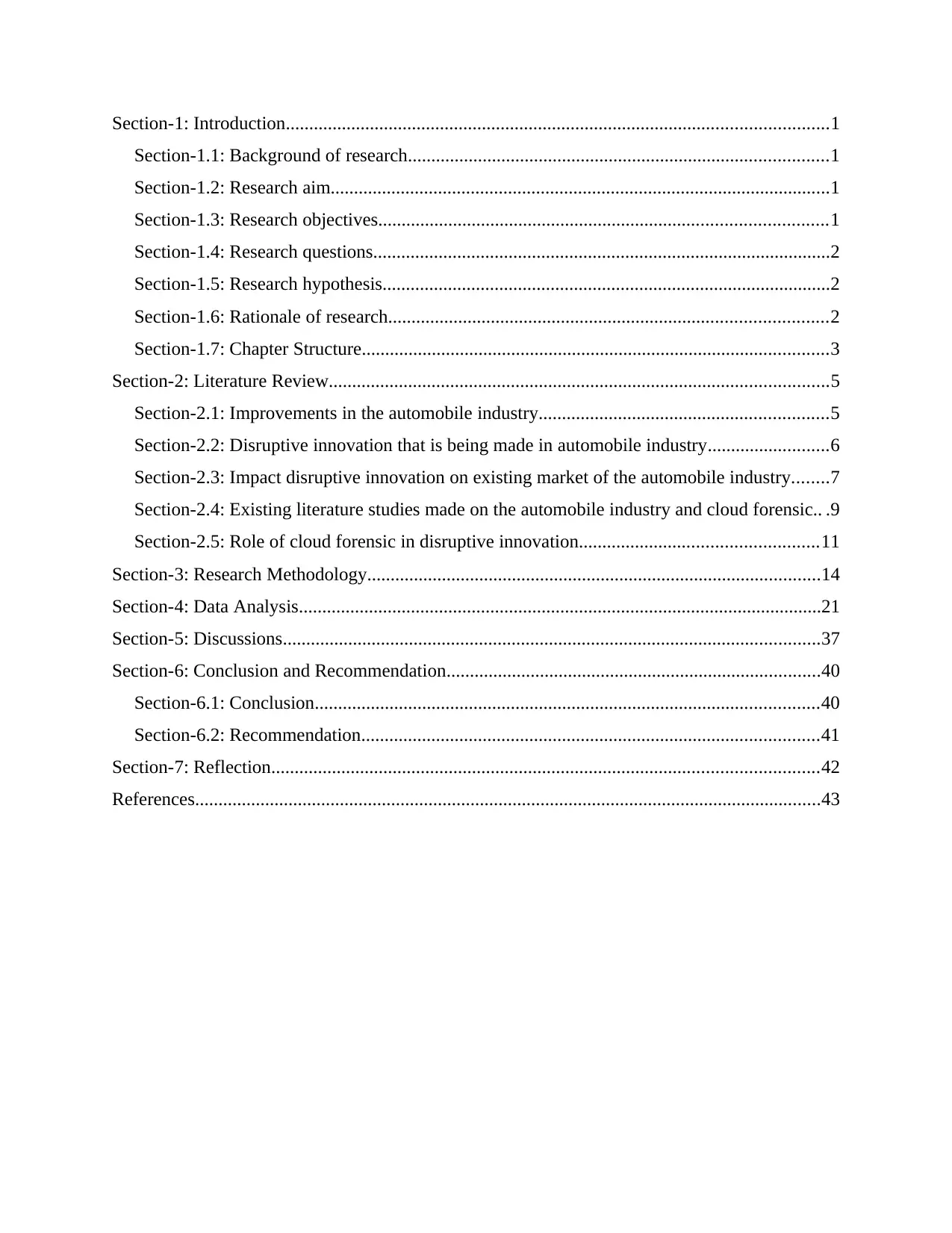
Section-1.1: Background of research..........................................................................................1
Section-1.2: Research aim...........................................................................................................1
Section-1.3: Research objectives................................................................................................1
Section-1.4: Research questions..................................................................................................2
Section-1.5: Research hypothesis................................................................................................2
Section-1.6: Rationale of research..............................................................................................2
Section-1.7: Chapter Structure....................................................................................................3
Section-2: Literature Review...........................................................................................................5
Section-2.1: Improvements in the automobile industry..............................................................5
Section-2.2: Disruptive innovation that is being made in automobile industry..........................6
Section-2.3: Impact disruptive innovation on existing market of the automobile industry........7
Section-2.4: Existing literature studies made on the automobile industry and cloud forensic.. .9
Section-2.5: Role of cloud forensic in disruptive innovation...................................................11
Section-3: Research Methodology.................................................................................................14
Section-4: Data Analysis................................................................................................................21
Section-5: Discussions...................................................................................................................37
Section-6: Conclusion and Recommendation................................................................................40
Section-6.1: Conclusion............................................................................................................40
Section-6.2: Recommendation..................................................................................................41
Section-7: Reflection.....................................................................................................................42
References......................................................................................................................................43
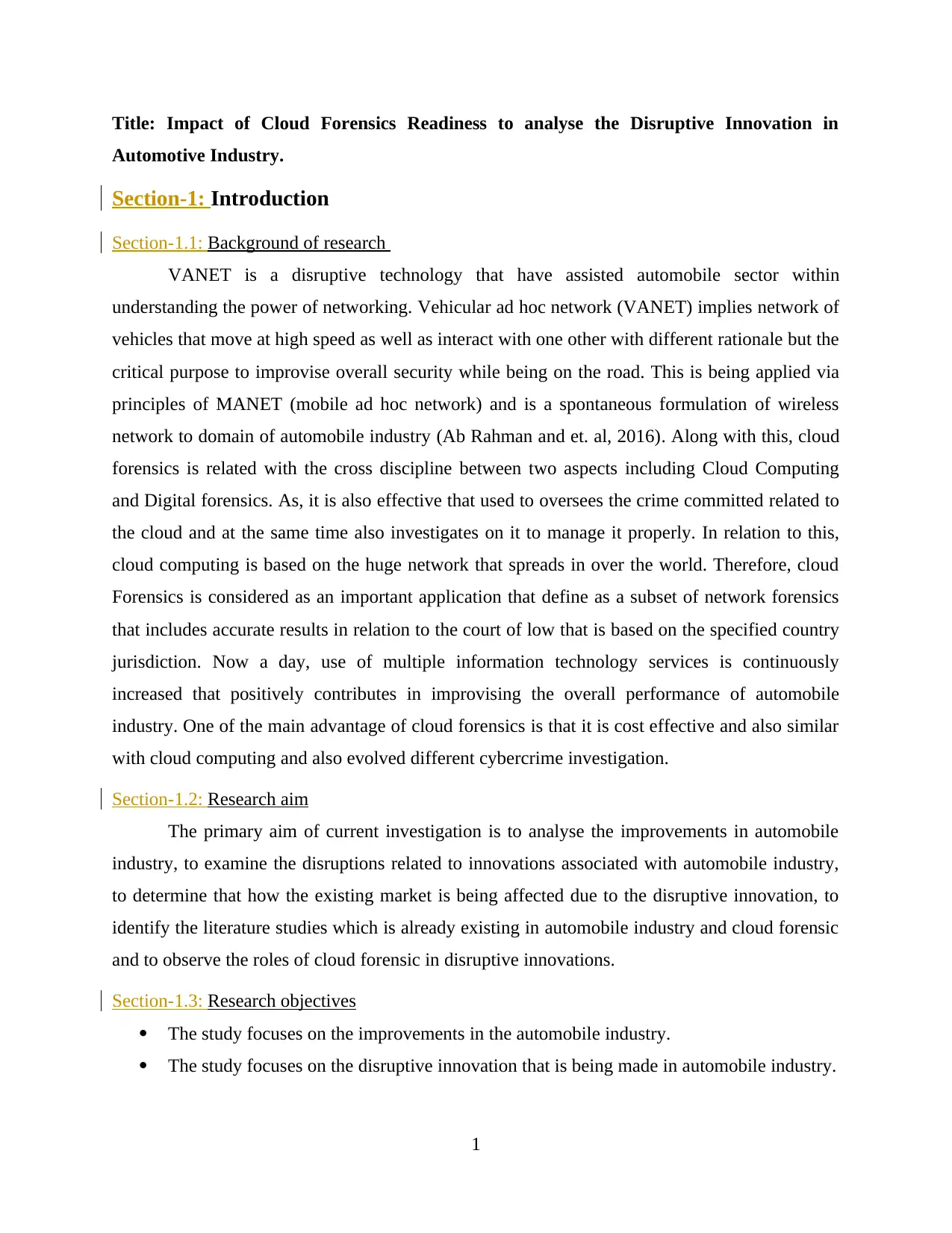
Automotive Industry.
Section-1: Introduction
Section-1.1: Background of research
VANET is a disruptive technology that have assisted automobile sector within
understanding the power of networking. Vehicular ad hoc network (VANET) implies network of
vehicles that move at high speed as well as interact with one other with different rationale but the
critical purpose to improvise overall security while being on the road. This is being applied via
principles of MANET (mobile ad hoc network) and is a spontaneous formulation of wireless
network to domain of automobile industry (Ab Rahman and et. al, 2016). Along with this, cloud
forensics is related with the cross discipline between two aspects including Cloud Computing
and Digital forensics. As, it is also effective that used to oversees the crime committed related to
the cloud and at the same time also investigates on it to manage it properly. In relation to this,
cloud computing is based on the huge network that spreads in over the world. Therefore, cloud
Forensics is considered as an important application that define as a subset of network forensics
that includes accurate results in relation to the court of low that is based on the specified country
jurisdiction. Now a day, use of multiple information technology services is continuously
increased that positively contributes in improvising the overall performance of automobile
industry. One of the main advantage of cloud forensics is that it is cost effective and also similar
with cloud computing and also evolved different cybercrime investigation.
Section-1.2: Research aim
The primary aim of current investigation is to analyse the improvements in automobile
industry, to examine the disruptions related to innovations associated with automobile industry,
to determine that how the existing market is being affected due to the disruptive innovation, to
identify the literature studies which is already existing in automobile industry and cloud forensic
and to observe the roles of cloud forensic in disruptive innovations.
Section-1.3: Research objectives
The study focuses on the improvements in the automobile industry.
The study focuses on the disruptive innovation that is being made in automobile industry.
1
You're viewing a preview
Unlock full access by subscribing today!
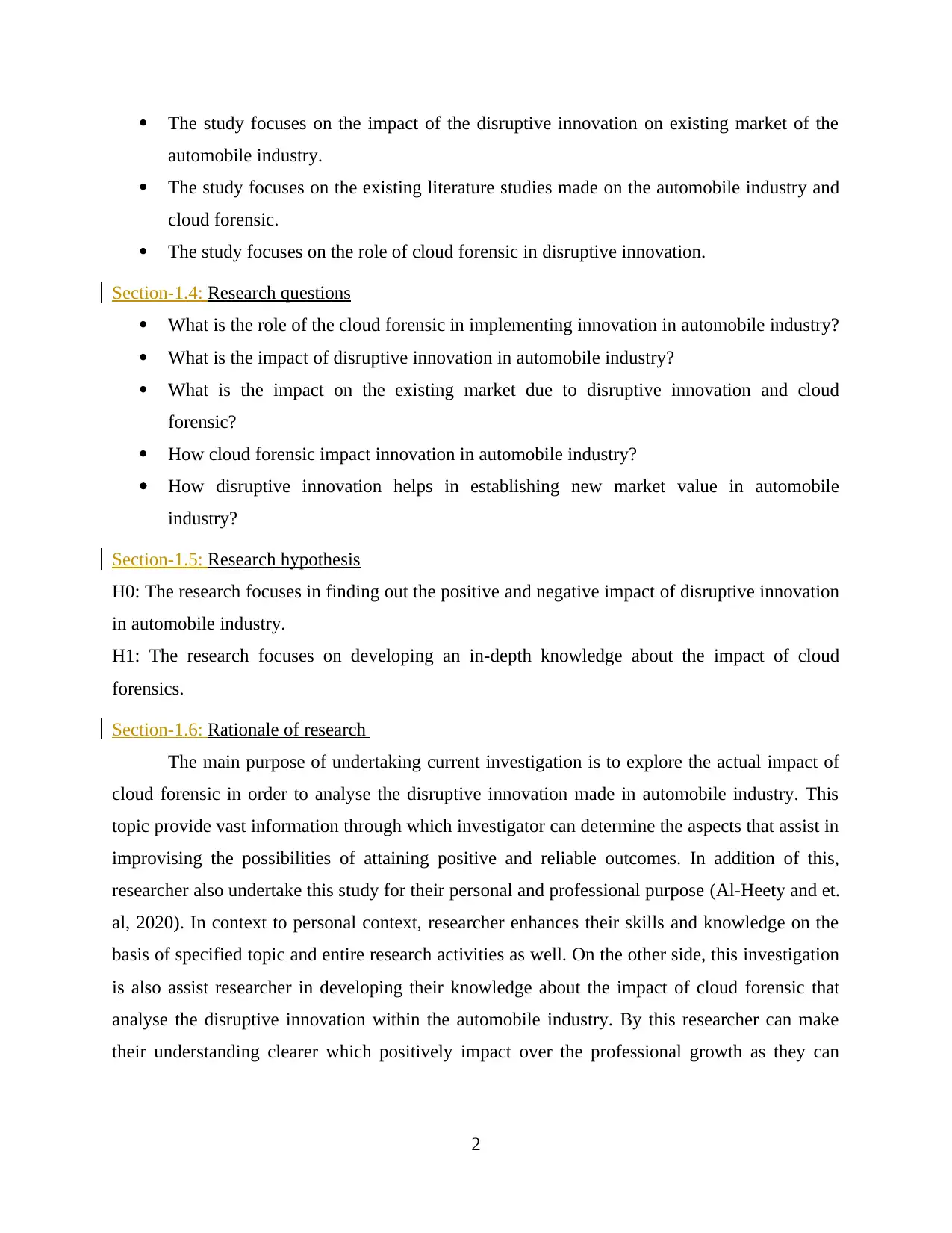
automobile industry.
The study focuses on the existing literature studies made on the automobile industry and
cloud forensic.
The study focuses on the role of cloud forensic in disruptive innovation.
Section-1.4: Research questions
What is the role of the cloud forensic in implementing innovation in automobile industry?
What is the impact of disruptive innovation in automobile industry?
What is the impact on the existing market due to disruptive innovation and cloud
forensic?
How cloud forensic impact innovation in automobile industry?
How disruptive innovation helps in establishing new market value in automobile
industry?
Section-1.5: Research hypothesis
H0: The research focuses in finding out the positive and negative impact of disruptive innovation
in automobile industry.
H1: The research focuses on developing an in-depth knowledge about the impact of cloud
forensics.
Section-1.6: Rationale of research
The main purpose of undertaking current investigation is to explore the actual impact of
cloud forensic in order to analyse the disruptive innovation made in automobile industry. This
topic provide vast information through which investigator can determine the aspects that assist in
improvising the possibilities of attaining positive and reliable outcomes. In addition of this,
researcher also undertake this study for their personal and professional purpose (Al-Heety and et.
al, 2020). In context to personal context, researcher enhances their skills and knowledge on the
basis of specified topic and entire research activities as well. On the other side, this investigation
is also assist researcher in developing their knowledge about the impact of cloud forensic that
analyse the disruptive innovation within the automobile industry. By this researcher can make
their understanding clearer which positively impact over the professional growth as they can
2
Paraphrase This Document
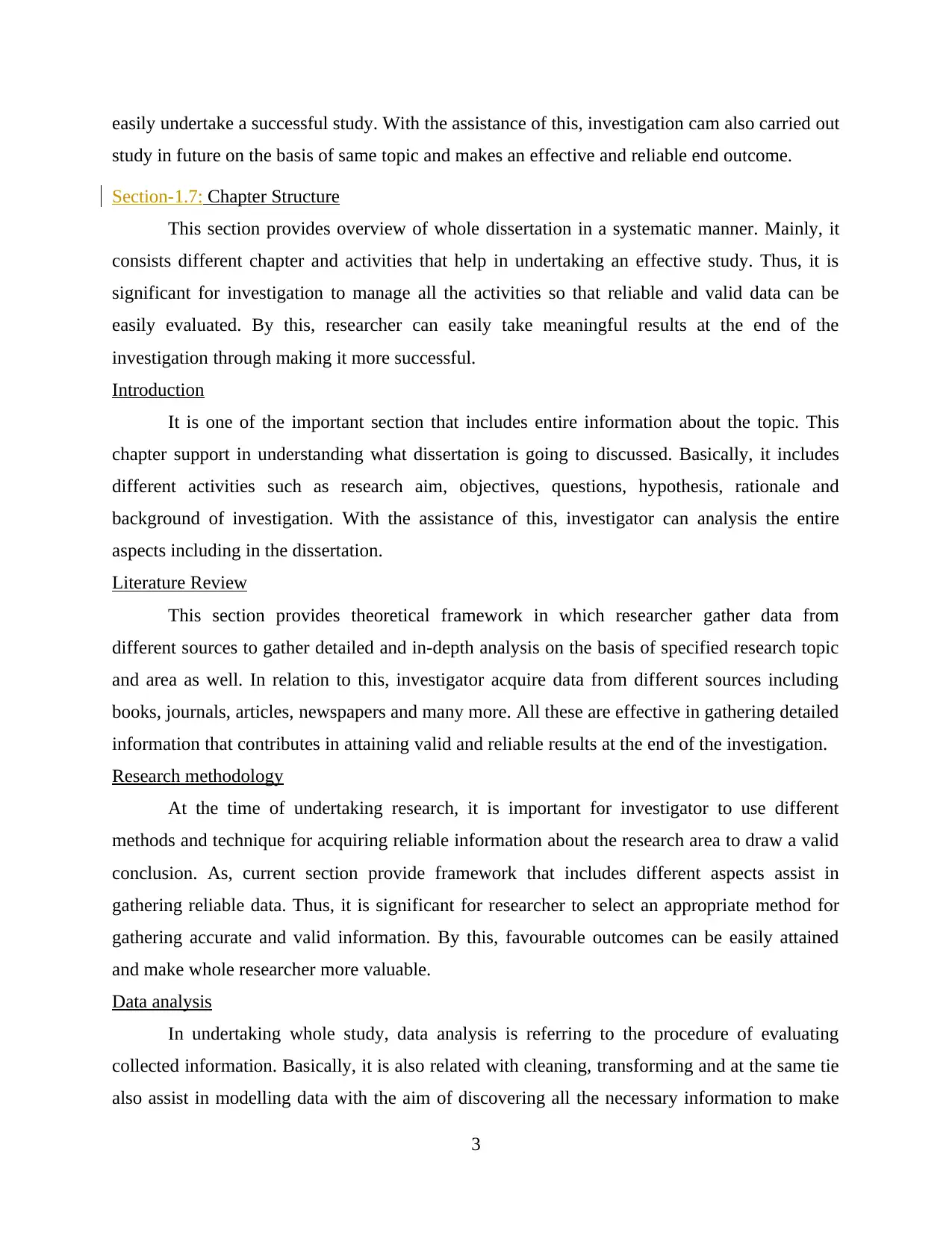
study in future on the basis of same topic and makes an effective and reliable end outcome.
Section-1.7: Chapter Structure
This section provides overview of whole dissertation in a systematic manner. Mainly, it
consists different chapter and activities that help in undertaking an effective study. Thus, it is
significant for investigation to manage all the activities so that reliable and valid data can be
easily evaluated. By this, researcher can easily take meaningful results at the end of the
investigation through making it more successful.
Introduction
It is one of the important section that includes entire information about the topic. This
chapter support in understanding what dissertation is going to discussed. Basically, it includes
different activities such as research aim, objectives, questions, hypothesis, rationale and
background of investigation. With the assistance of this, investigator can analysis the entire
aspects including in the dissertation.
Literature Review
This section provides theoretical framework in which researcher gather data from
different sources to gather detailed and in-depth analysis on the basis of specified research topic
and area as well. In relation to this, investigator acquire data from different sources including
books, journals, articles, newspapers and many more. All these are effective in gathering detailed
information that contributes in attaining valid and reliable results at the end of the investigation.
Research methodology
At the time of undertaking research, it is important for investigator to use different
methods and technique for acquiring reliable information about the research area to draw a valid
conclusion. As, current section provide framework that includes different aspects assist in
gathering reliable data. Thus, it is significant for researcher to select an appropriate method for
gathering accurate and valid information. By this, favourable outcomes can be easily attained
and make whole researcher more valuable.
Data analysis
In undertaking whole study, data analysis is referring to the procedure of evaluating
collected information. Basically, it is also related with cleaning, transforming and at the same tie
also assist in modelling data with the aim of discovering all the necessary information to make
3
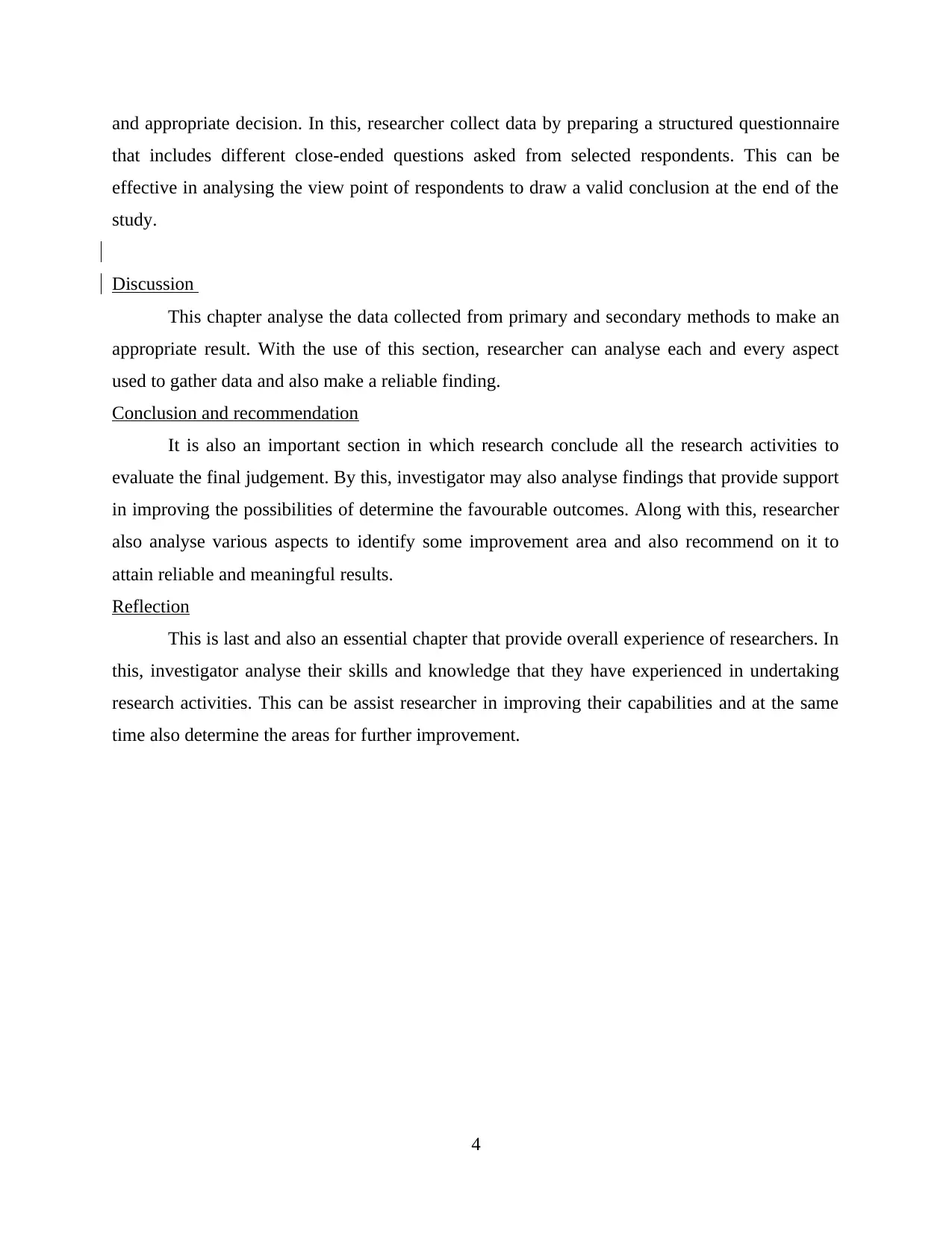
that includes different close-ended questions asked from selected respondents. This can be
effective in analysing the view point of respondents to draw a valid conclusion at the end of the
study.
Discussion
This chapter analyse the data collected from primary and secondary methods to make an
appropriate result. With the use of this section, researcher can analyse each and every aspect
used to gather data and also make a reliable finding.
Conclusion and recommendation
It is also an important section in which research conclude all the research activities to
evaluate the final judgement. By this, investigator may also analyse findings that provide support
in improving the possibilities of determine the favourable outcomes. Along with this, researcher
also analyse various aspects to identify some improvement area and also recommend on it to
attain reliable and meaningful results.
Reflection
This is last and also an essential chapter that provide overall experience of researchers. In
this, investigator analyse their skills and knowledge that they have experienced in undertaking
research activities. This can be assist researcher in improving their capabilities and at the same
time also determine the areas for further improvement.
4
You're viewing a preview
Unlock full access by subscribing today!
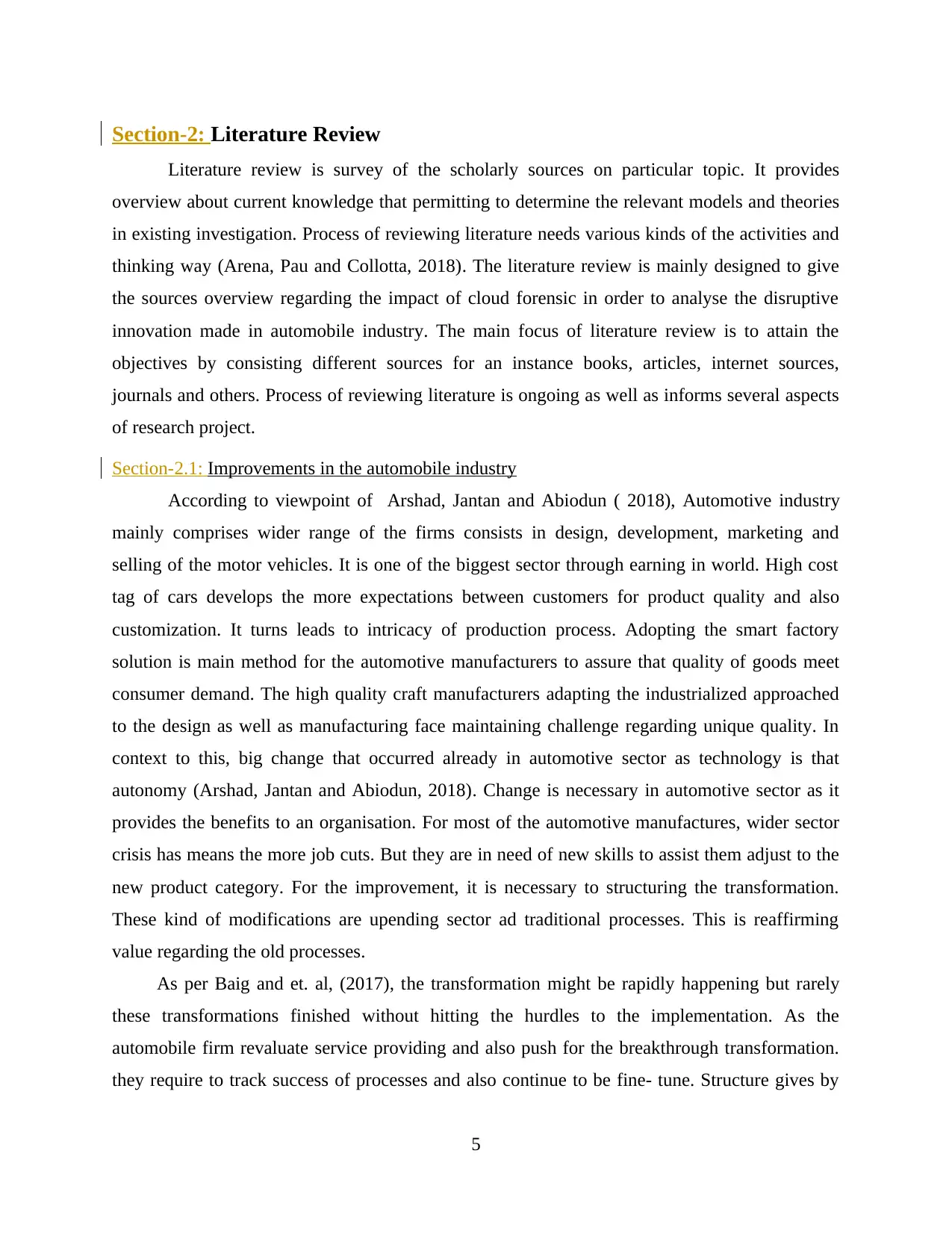
Literature review is survey of the scholarly sources on particular topic. It provides
overview about current knowledge that permitting to determine the relevant models and theories
in existing investigation. Process of reviewing literature needs various kinds of the activities and
thinking way (Arena, Pau and Collotta, 2018). The literature review is mainly designed to give
the sources overview regarding the impact of cloud forensic in order to analyse the disruptive
innovation made in automobile industry. The main focus of literature review is to attain the
objectives by consisting different sources for an instance books, articles, internet sources,
journals and others. Process of reviewing literature is ongoing as well as informs several aspects
of research project.
Section-2.1: Improvements in the automobile industry
According to viewpoint of Arshad, Jantan and Abiodun ( 2018), Automotive industry
mainly comprises wider range of the firms consists in design, development, marketing and
selling of the motor vehicles. It is one of the biggest sector through earning in world. High cost
tag of cars develops the more expectations between customers for product quality and also
customization. It turns leads to intricacy of production process. Adopting the smart factory
solution is main method for the automotive manufacturers to assure that quality of goods meet
consumer demand. The high quality craft manufacturers adapting the industrialized approached
to the design as well as manufacturing face maintaining challenge regarding unique quality. In
context to this, big change that occurred already in automotive sector as technology is that
autonomy (Arshad, Jantan and Abiodun, 2018). Change is necessary in automotive sector as it
provides the benefits to an organisation. For most of the automotive manufactures, wider sector
crisis has means the more job cuts. But they are in need of new skills to assist them adjust to the
new product category. For the improvement, it is necessary to structuring the transformation.
These kind of modifications are upending sector ad traditional processes. This is reaffirming
value regarding the old processes.
As per Baig and et. al, (2017), the transformation might be rapidly happening but rarely
these transformations finished without hitting the hurdles to the implementation. As the
automobile firm revaluate service providing and also push for the breakthrough transformation.
they require to track success of processes and also continue to be fine- tune. Structure gives by
5
Paraphrase This Document
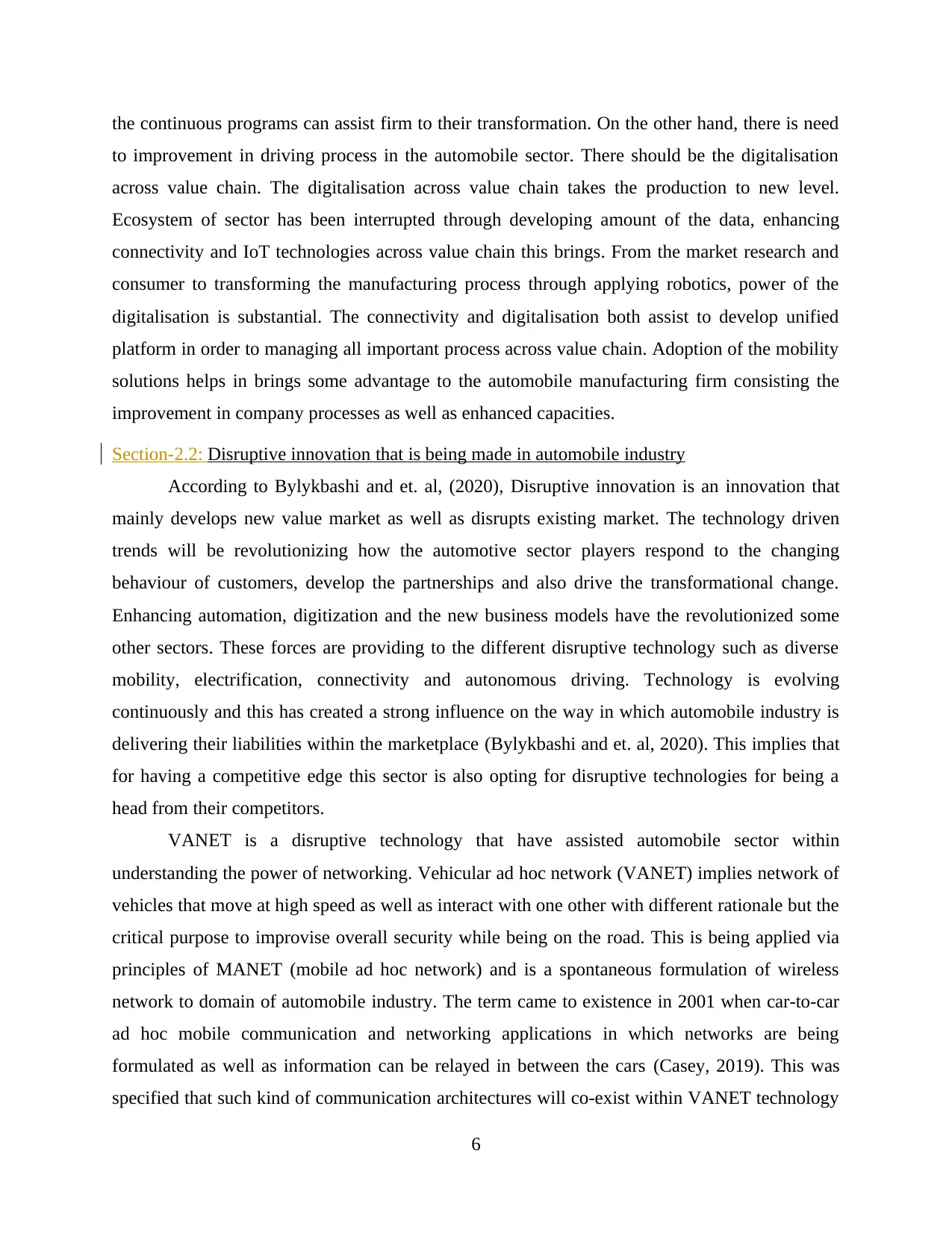
to improvement in driving process in the automobile sector. There should be the digitalisation
across value chain. The digitalisation across value chain takes the production to new level.
Ecosystem of sector has been interrupted through developing amount of the data, enhancing
connectivity and IoT technologies across value chain this brings. From the market research and
consumer to transforming the manufacturing process through applying robotics, power of the
digitalisation is substantial. The connectivity and digitalisation both assist to develop unified
platform in order to managing all important process across value chain. Adoption of the mobility
solutions helps in brings some advantage to the automobile manufacturing firm consisting the
improvement in company processes as well as enhanced capacities.
Section-2.2: Disruptive innovation that is being made in automobile industry
According to Bylykbashi and et. al, (2020), Disruptive innovation is an innovation that
mainly develops new value market as well as disrupts existing market. The technology driven
trends will be revolutionizing how the automotive sector players respond to the changing
behaviour of customers, develop the partnerships and also drive the transformational change.
Enhancing automation, digitization and the new business models have the revolutionized some
other sectors. These forces are providing to the different disruptive technology such as diverse
mobility, electrification, connectivity and autonomous driving. Technology is evolving
continuously and this has created a strong influence on the way in which automobile industry is
delivering their liabilities within the marketplace (Bylykbashi and et. al, 2020). This implies that
for having a competitive edge this sector is also opting for disruptive technologies for being a
head from their competitors.
VANET is a disruptive technology that have assisted automobile sector within
understanding the power of networking. Vehicular ad hoc network (VANET) implies network of
vehicles that move at high speed as well as interact with one other with different rationale but the
critical purpose to improvise overall security while being on the road. This is being applied via
principles of MANET (mobile ad hoc network) and is a spontaneous formulation of wireless
network to domain of automobile industry. The term came to existence in 2001 when car-to-car
ad hoc mobile communication and networking applications in which networks are being
formulated as well as information can be relayed in between the cars (Casey, 2019). This was
specified that such kind of communication architectures will co-exist within VANET technology
6
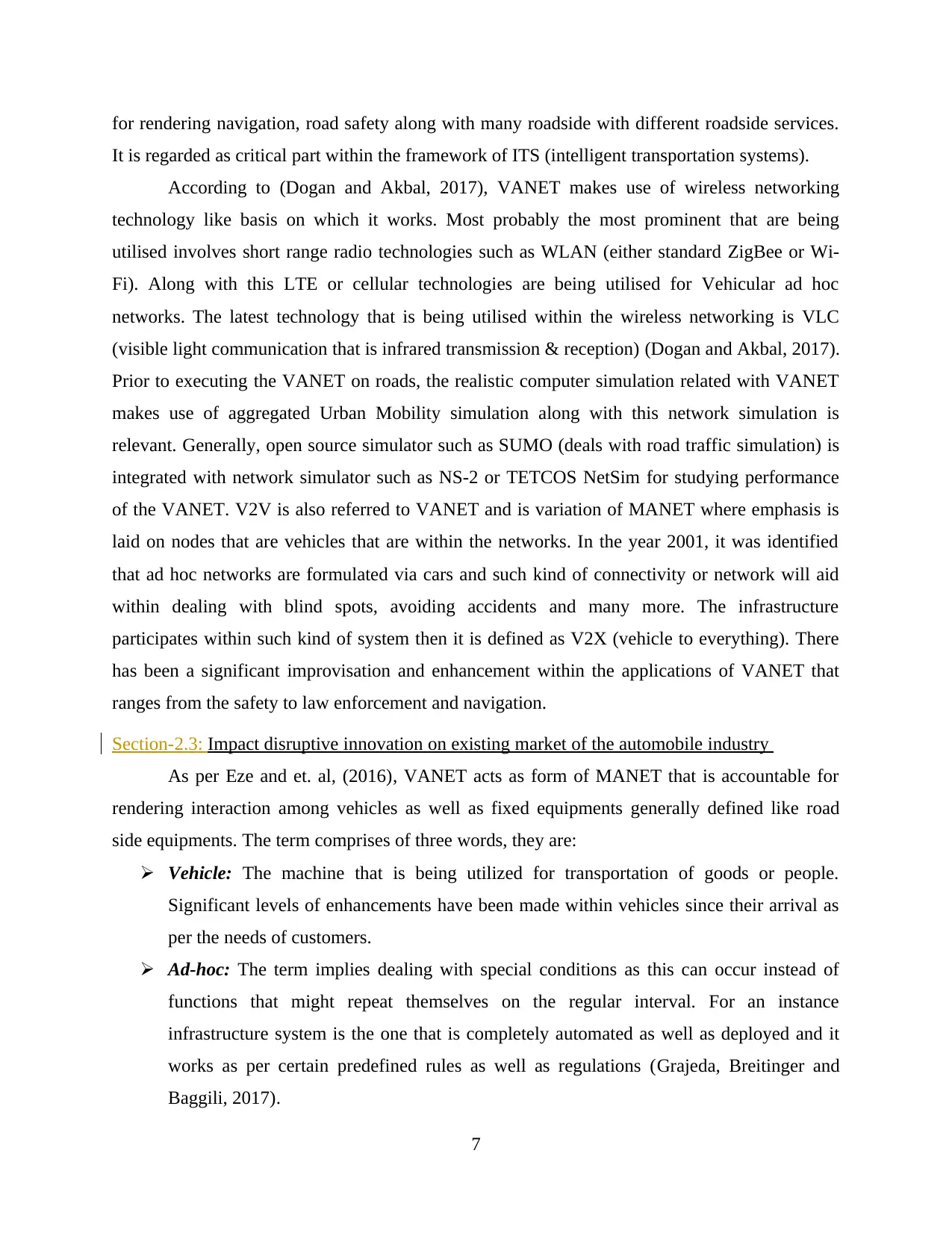
It is regarded as critical part within the framework of ITS (intelligent transportation systems).
According to (Dogan and Akbal, 2017), VANET makes use of wireless networking
technology like basis on which it works. Most probably the most prominent that are being
utilised involves short range radio technologies such as WLAN (either standard ZigBee or Wi-
Fi). Along with this LTE or cellular technologies are being utilised for Vehicular ad hoc
networks. The latest technology that is being utilised within the wireless networking is VLC
(visible light communication that is infrared transmission & reception) (Dogan and Akbal, 2017).
Prior to executing the VANET on roads, the realistic computer simulation related with VANET
makes use of aggregated Urban Mobility simulation along with this network simulation is
relevant. Generally, open source simulator such as SUMO (deals with road traffic simulation) is
integrated with network simulator such as NS-2 or TETCOS NetSim for studying performance
of the VANET. V2V is also referred to VANET and is variation of MANET where emphasis is
laid on nodes that are vehicles that are within the networks. In the year 2001, it was identified
that ad hoc networks are formulated via cars and such kind of connectivity or network will aid
within dealing with blind spots, avoiding accidents and many more. The infrastructure
participates within such kind of system then it is defined as V2X (vehicle to everything). There
has been a significant improvisation and enhancement within the applications of VANET that
ranges from the safety to law enforcement and navigation.
Section-2.3: Impact disruptive innovation on existing market of the automobile industry
As per Eze and et. al, (2016), VANET acts as form of MANET that is accountable for
rendering interaction among vehicles as well as fixed equipments generally defined like road
side equipments. The term comprises of three words, they are:
Vehicle: The machine that is being utilized for transportation of goods or people.
Significant levels of enhancements have been made within vehicles since their arrival as
per the needs of customers.
Ad-hoc: The term implies dealing with special conditions as this can occur instead of
functions that might repeat themselves on the regular interval. For an instance
infrastructure system is the one that is completely automated as well as deployed and it
works as per certain predefined rules as well as regulations (Grajeda, Breitinger and
Baggili, 2017).
7
You're viewing a preview
Unlock full access by subscribing today!
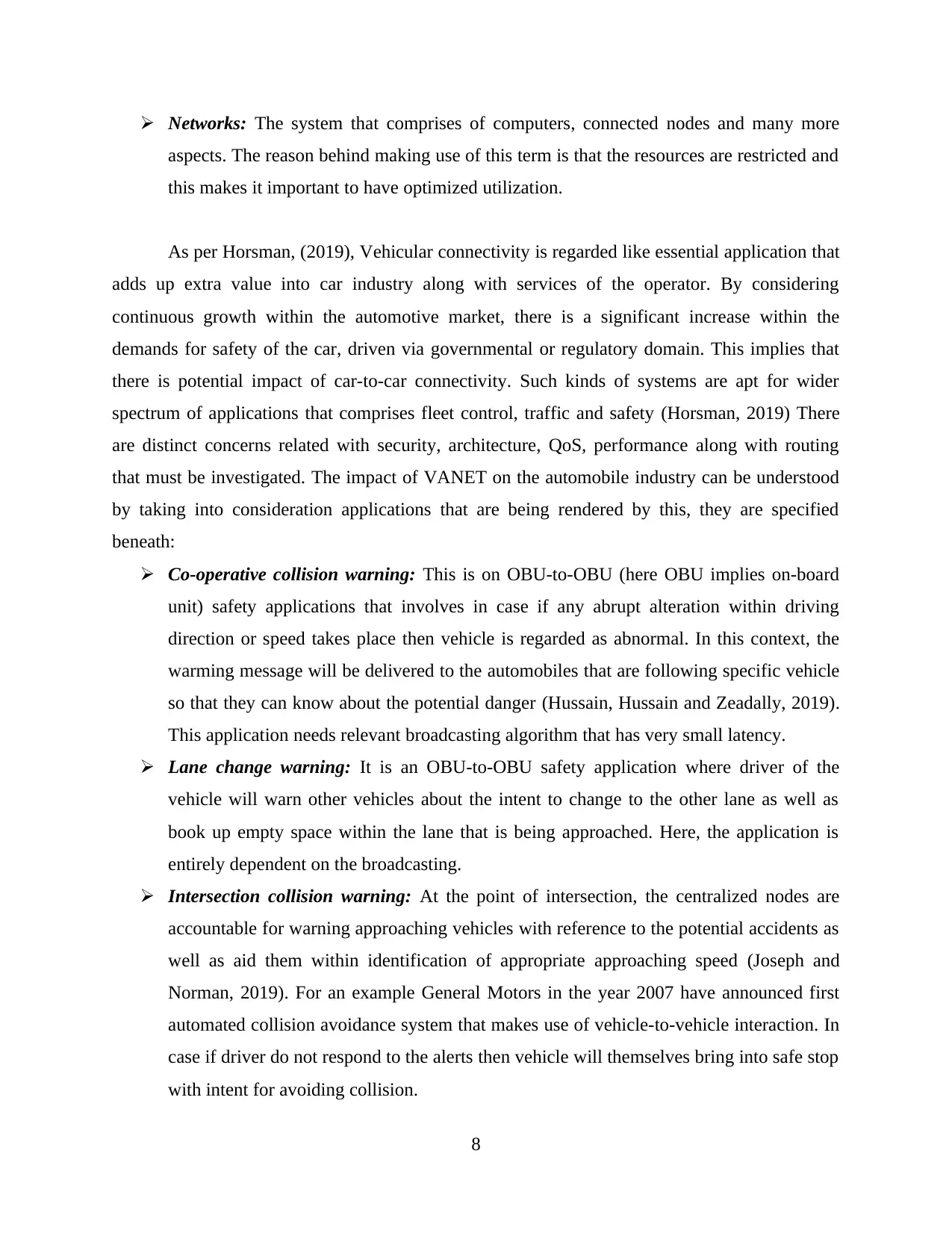
aspects. The reason behind making use of this term is that the resources are restricted and
this makes it important to have optimized utilization.
As per Horsman, (2019), Vehicular connectivity is regarded like essential application that
adds up extra value into car industry along with services of the operator. By considering
continuous growth within the automotive market, there is a significant increase within the
demands for safety of the car, driven via governmental or regulatory domain. This implies that
there is potential impact of car-to-car connectivity. Such kinds of systems are apt for wider
spectrum of applications that comprises fleet control, traffic and safety (Horsman, 2019) There
are distinct concerns related with security, architecture, QoS, performance along with routing
that must be investigated. The impact of VANET on the automobile industry can be understood
by taking into consideration applications that are being rendered by this, they are specified
beneath:
Co-operative collision warning: This is on OBU-to-OBU (here OBU implies on-board
unit) safety applications that involves in case if any abrupt alteration within driving
direction or speed takes place then vehicle is regarded as abnormal. In this context, the
warming message will be delivered to the automobiles that are following specific vehicle
so that they can know about the potential danger (Hussain, Hussain and Zeadally, 2019).
This application needs relevant broadcasting algorithm that has very small latency.
Lane change warning: It is an OBU-to-OBU safety application where driver of the
vehicle will warn other vehicles about the intent to change to the other lane as well as
book up empty space within the lane that is being approached. Here, the application is
entirely dependent on the broadcasting.
Intersection collision warning: At the point of intersection, the centralized nodes are
accountable for warning approaching vehicles with reference to the potential accidents as
well as aid them within identification of appropriate approaching speed (Joseph and
Norman, 2019). For an example General Motors in the year 2007 have announced first
automated collision avoidance system that makes use of vehicle-to-vehicle interaction. In
case if driver do not respond to the alerts then vehicle will themselves bring into safe stop
with intent for avoiding collision.
8
Paraphrase This Document
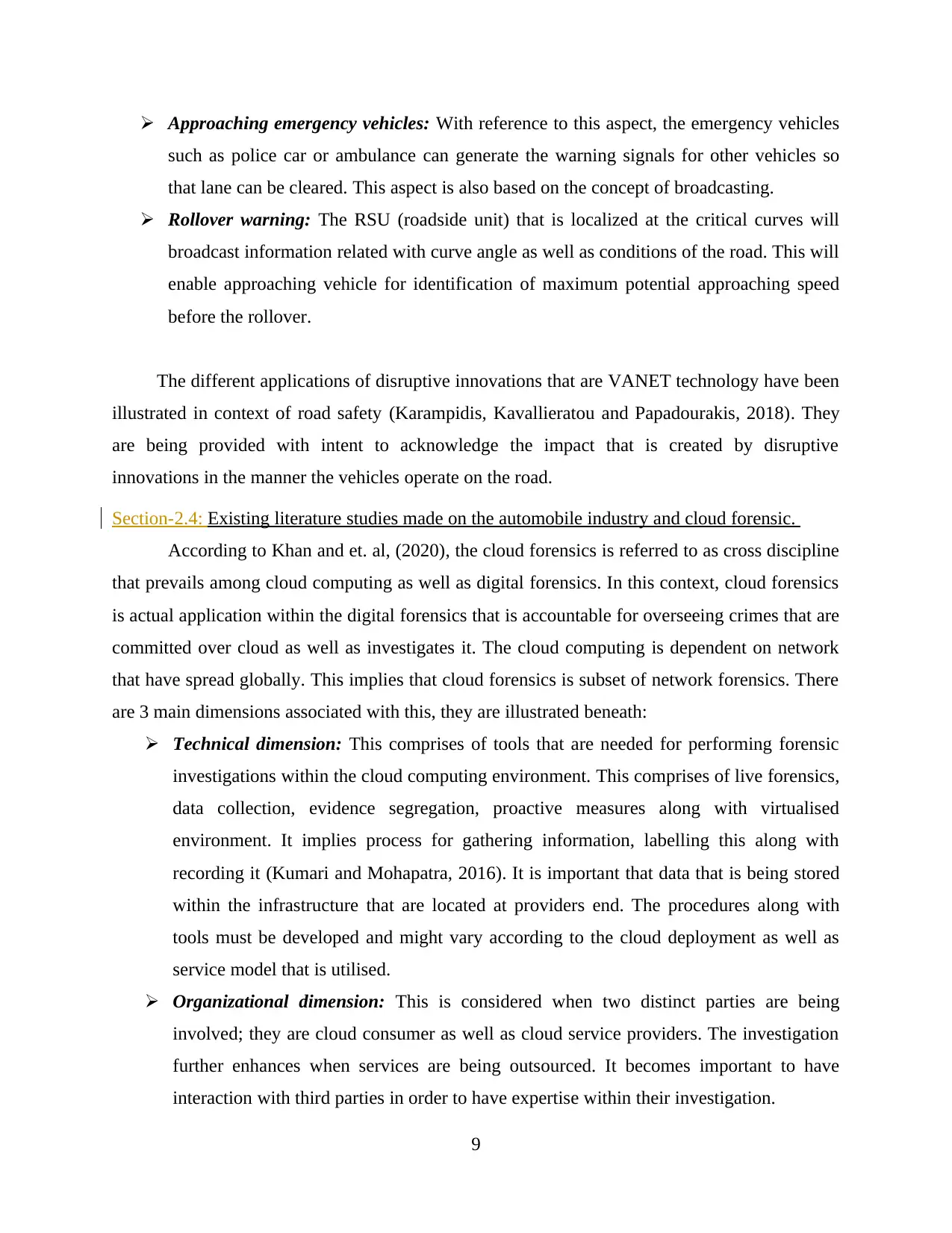
such as police car or ambulance can generate the warning signals for other vehicles so
that lane can be cleared. This aspect is also based on the concept of broadcasting.
Rollover warning: The RSU (roadside unit) that is localized at the critical curves will
broadcast information related with curve angle as well as conditions of the road. This will
enable approaching vehicle for identification of maximum potential approaching speed
before the rollover.
The different applications of disruptive innovations that are VANET technology have been
illustrated in context of road safety (Karampidis, Kavallieratou and Papadourakis, 2018). They
are being provided with intent to acknowledge the impact that is created by disruptive
innovations in the manner the vehicles operate on the road.
Section-2.4: Existing literature studies made on the automobile industry and cloud forensic.
According to Khan and et. al, (2020), the cloud forensics is referred to as cross discipline
that prevails among cloud computing as well as digital forensics. In this context, cloud forensics
is actual application within the digital forensics that is accountable for overseeing crimes that are
committed over cloud as well as investigates it. The cloud computing is dependent on network
that have spread globally. This implies that cloud forensics is subset of network forensics. There
are 3 main dimensions associated with this, they are illustrated beneath:
Technical dimension: This comprises of tools that are needed for performing forensic
investigations within the cloud computing environment. This comprises of live forensics,
data collection, evidence segregation, proactive measures along with virtualised
environment. It implies process for gathering information, labelling this along with
recording it (Kumari and Mohapatra, 2016). It is important that data that is being stored
within the infrastructure that are located at providers end. The procedures along with
tools must be developed and might vary according to the cloud deployment as well as
service model that is utilised.
Organizational dimension: This is considered when two distinct parties are being
involved; they are cloud consumer as well as cloud service providers. The investigation
further enhances when services are being outsourced. It becomes important to have
interaction with third parties in order to have expertise within their investigation.
9
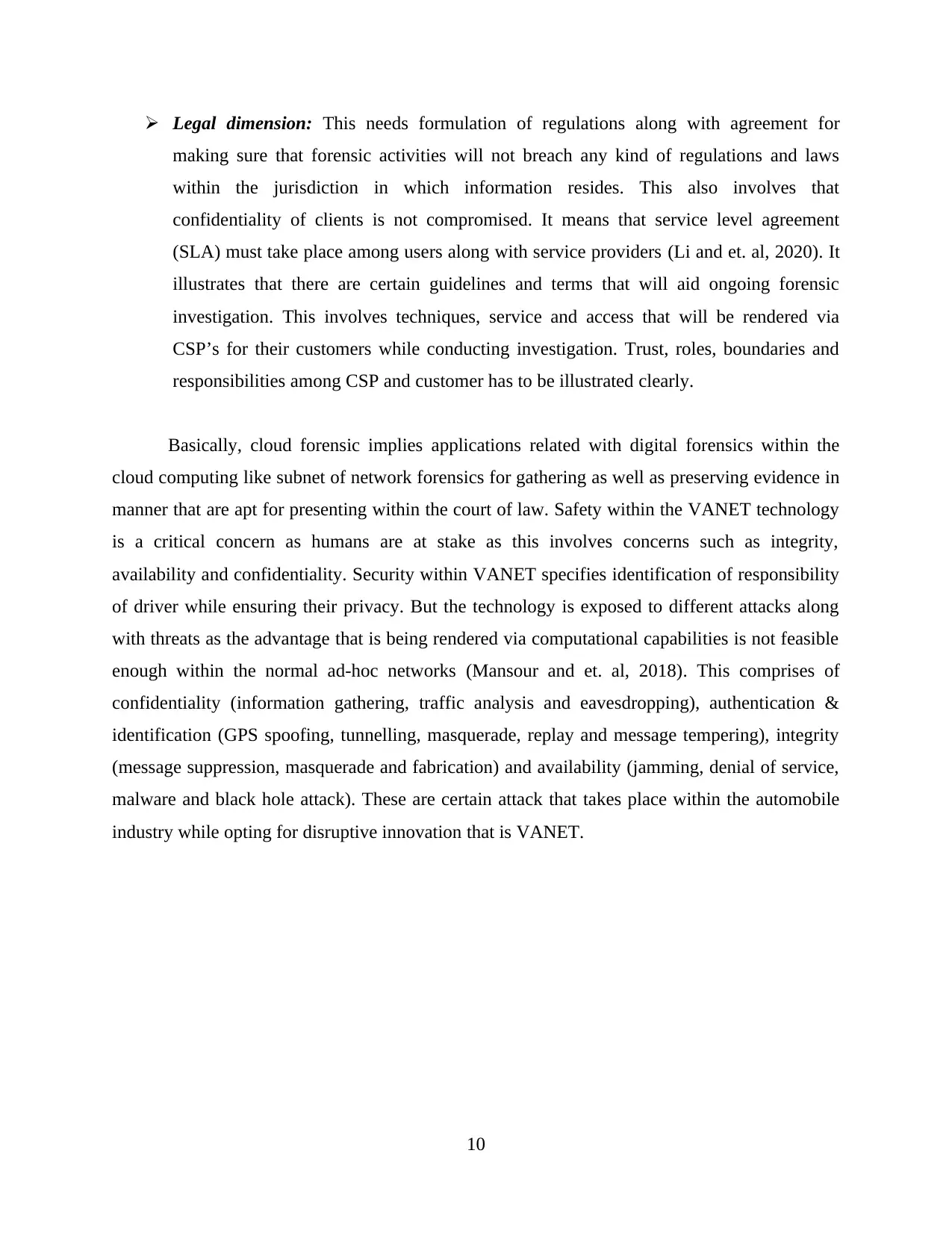
making sure that forensic activities will not breach any kind of regulations and laws
within the jurisdiction in which information resides. This also involves that
confidentiality of clients is not compromised. It means that service level agreement
(SLA) must take place among users along with service providers (Li and et. al, 2020). It
illustrates that there are certain guidelines and terms that will aid ongoing forensic
investigation. This involves techniques, service and access that will be rendered via
CSP’s for their customers while conducting investigation. Trust, roles, boundaries and
responsibilities among CSP and customer has to be illustrated clearly.
Basically, cloud forensic implies applications related with digital forensics within the
cloud computing like subnet of network forensics for gathering as well as preserving evidence in
manner that are apt for presenting within the court of law. Safety within the VANET technology
is a critical concern as humans are at stake as this involves concerns such as integrity,
availability and confidentiality. Security within VANET specifies identification of responsibility
of driver while ensuring their privacy. But the technology is exposed to different attacks along
with threats as the advantage that is being rendered via computational capabilities is not feasible
enough within the normal ad-hoc networks (Mansour and et. al, 2018). This comprises of
confidentiality (information gathering, traffic analysis and eavesdropping), authentication &
identification (GPS spoofing, tunnelling, masquerade, replay and message tempering), integrity
(message suppression, masquerade and fabrication) and availability (jamming, denial of service,
malware and black hole attack). These are certain attack that takes place within the automobile
industry while opting for disruptive innovation that is VANET.
10
You're viewing a preview
Unlock full access by subscribing today!
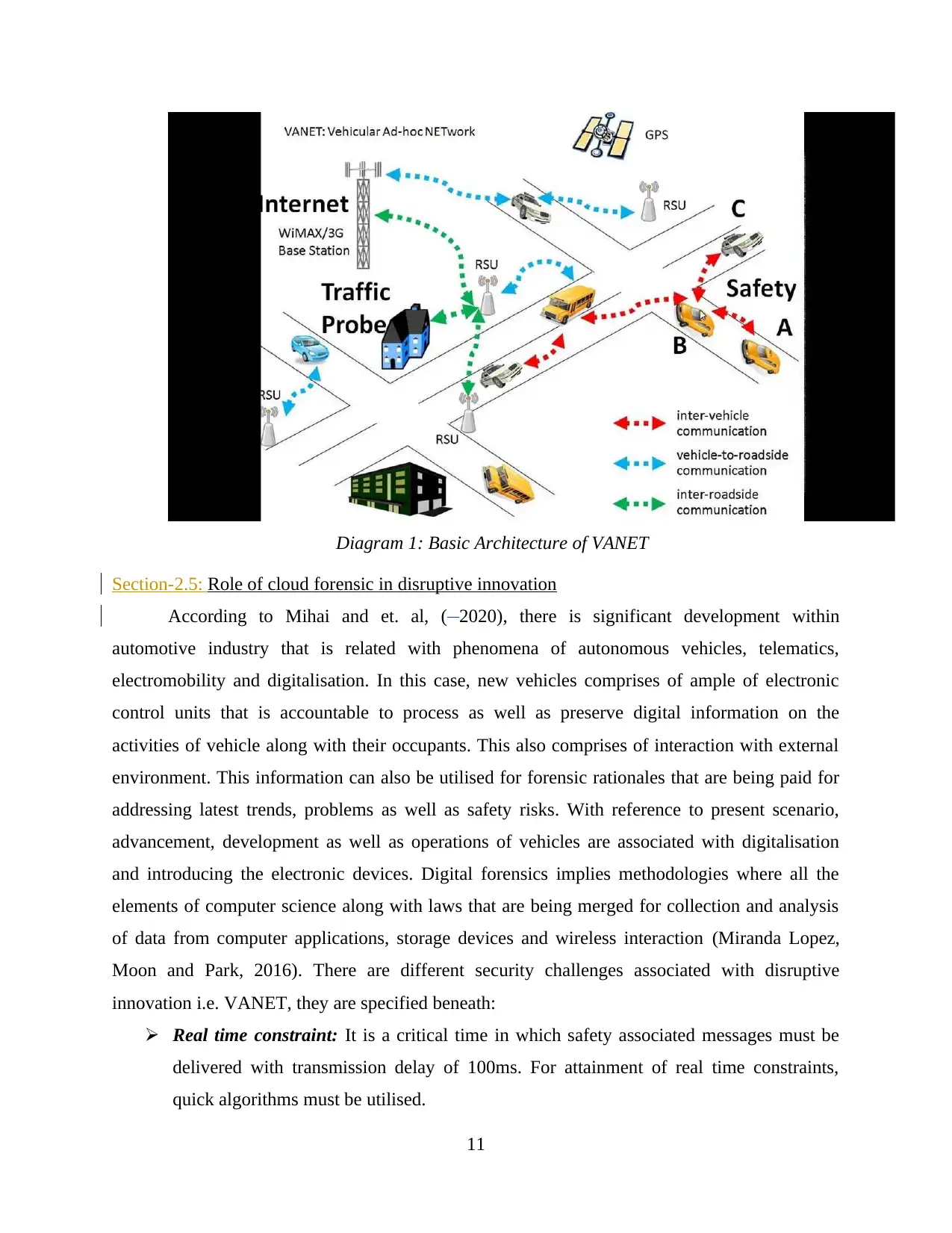
Section-2.5: Role of cloud forensic in disruptive innovation
According to Mihai and et. al, ( 2020), there is significant development within
automotive industry that is related with phenomena of autonomous vehicles, telematics,
electromobility and digitalisation. In this case, new vehicles comprises of ample of electronic
control units that is accountable to process as well as preserve digital information on the
activities of vehicle along with their occupants. This also comprises of interaction with external
environment. This information can also be utilised for forensic rationales that are being paid for
addressing latest trends, problems as well as safety risks. With reference to present scenario,
advancement, development as well as operations of vehicles are associated with digitalisation
and introducing the electronic devices. Digital forensics implies methodologies where all the
elements of computer science along with laws that are being merged for collection and analysis
of data from computer applications, storage devices and wireless interaction (Miranda Lopez,
Moon and Park, 2016). There are different security challenges associated with disruptive
innovation i.e. VANET, they are specified beneath:
Real time constraint: It is a critical time in which safety associated messages must be
delivered with transmission delay of 100ms. For attainment of real time constraints,
quick algorithms must be utilised.
11
Paraphrase This Document
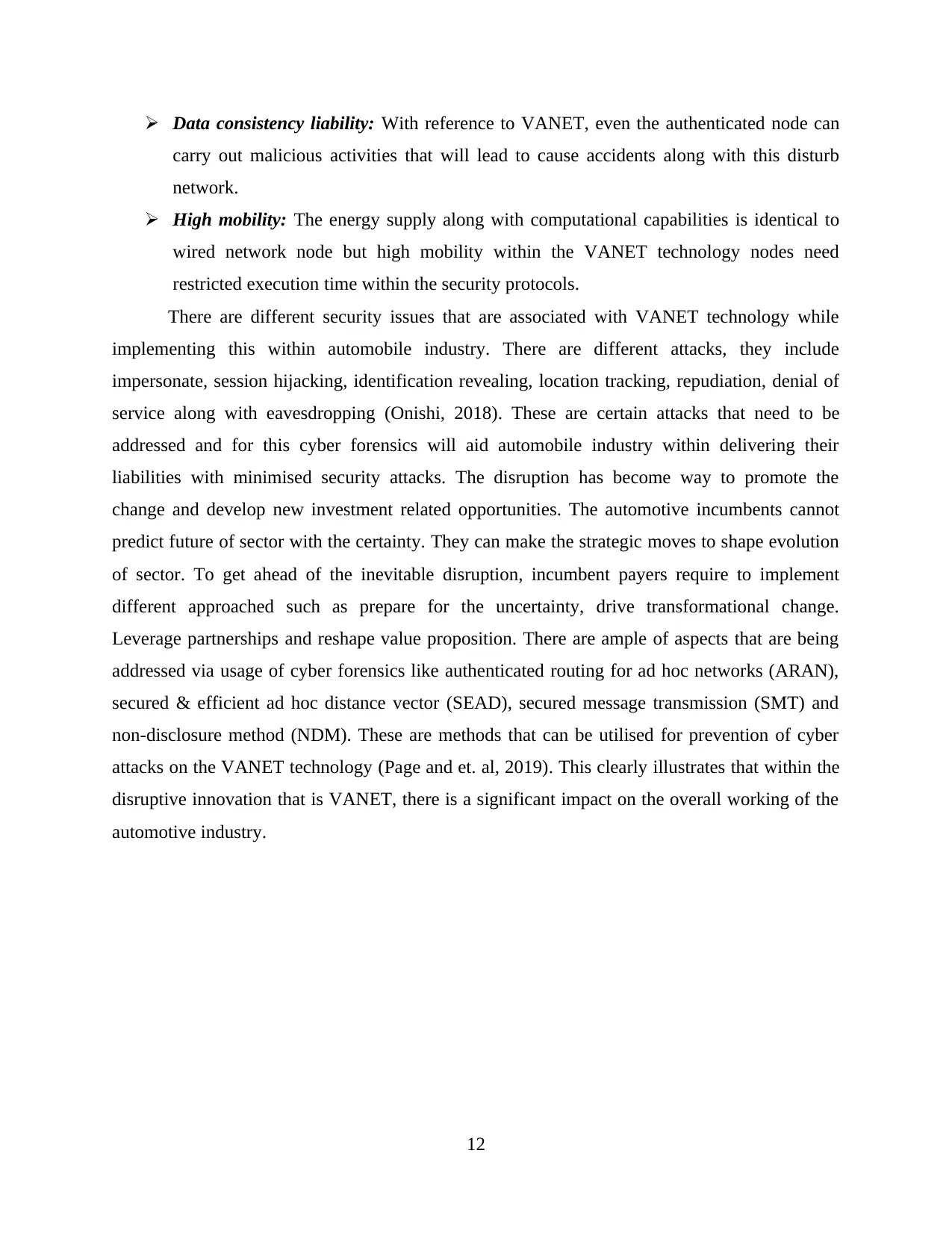
carry out malicious activities that will lead to cause accidents along with this disturb
network.
High mobility: The energy supply along with computational capabilities is identical to
wired network node but high mobility within the VANET technology nodes need
restricted execution time within the security protocols.
There are different security issues that are associated with VANET technology while
implementing this within automobile industry. There are different attacks, they include
impersonate, session hijacking, identification revealing, location tracking, repudiation, denial of
service along with eavesdropping (Onishi, 2018). These are certain attacks that need to be
addressed and for this cyber forensics will aid automobile industry within delivering their
liabilities with minimised security attacks. The disruption has become way to promote the
change and develop new investment related opportunities. The automotive incumbents cannot
predict future of sector with the certainty. They can make the strategic moves to shape evolution
of sector. To get ahead of the inevitable disruption, incumbent payers require to implement
different approached such as prepare for the uncertainty, drive transformational change.
Leverage partnerships and reshape value proposition. There are ample of aspects that are being
addressed via usage of cyber forensics like authenticated routing for ad hoc networks (ARAN),
secured & efficient ad hoc distance vector (SEAD), secured message transmission (SMT) and
non-disclosure method (NDM). These are methods that can be utilised for prevention of cyber
attacks on the VANET technology (Page and et. al, 2019). This clearly illustrates that within the
disruptive innovation that is VANET, there is a significant impact on the overall working of the
automotive industry.
12
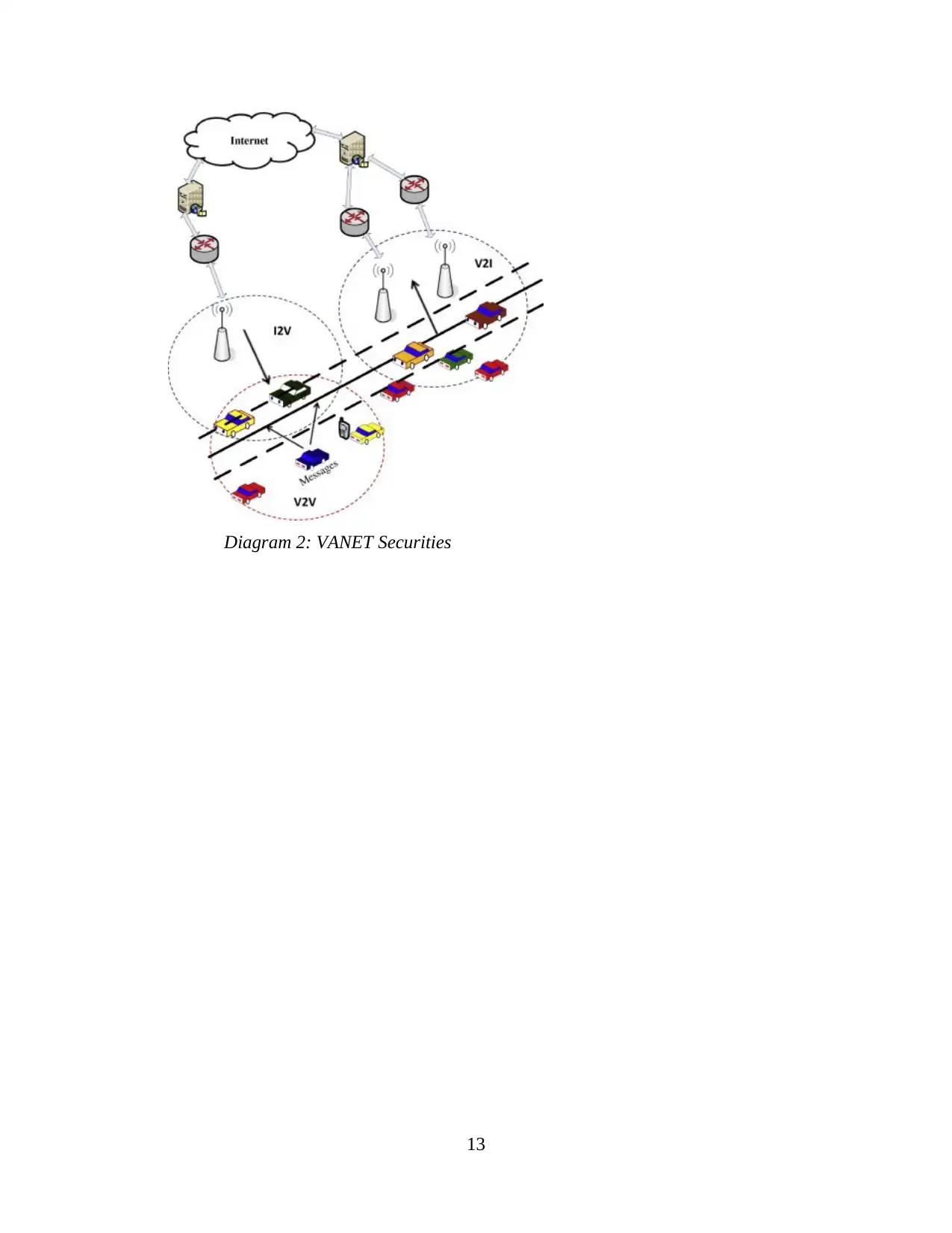
13
You're viewing a preview
Unlock full access by subscribing today!
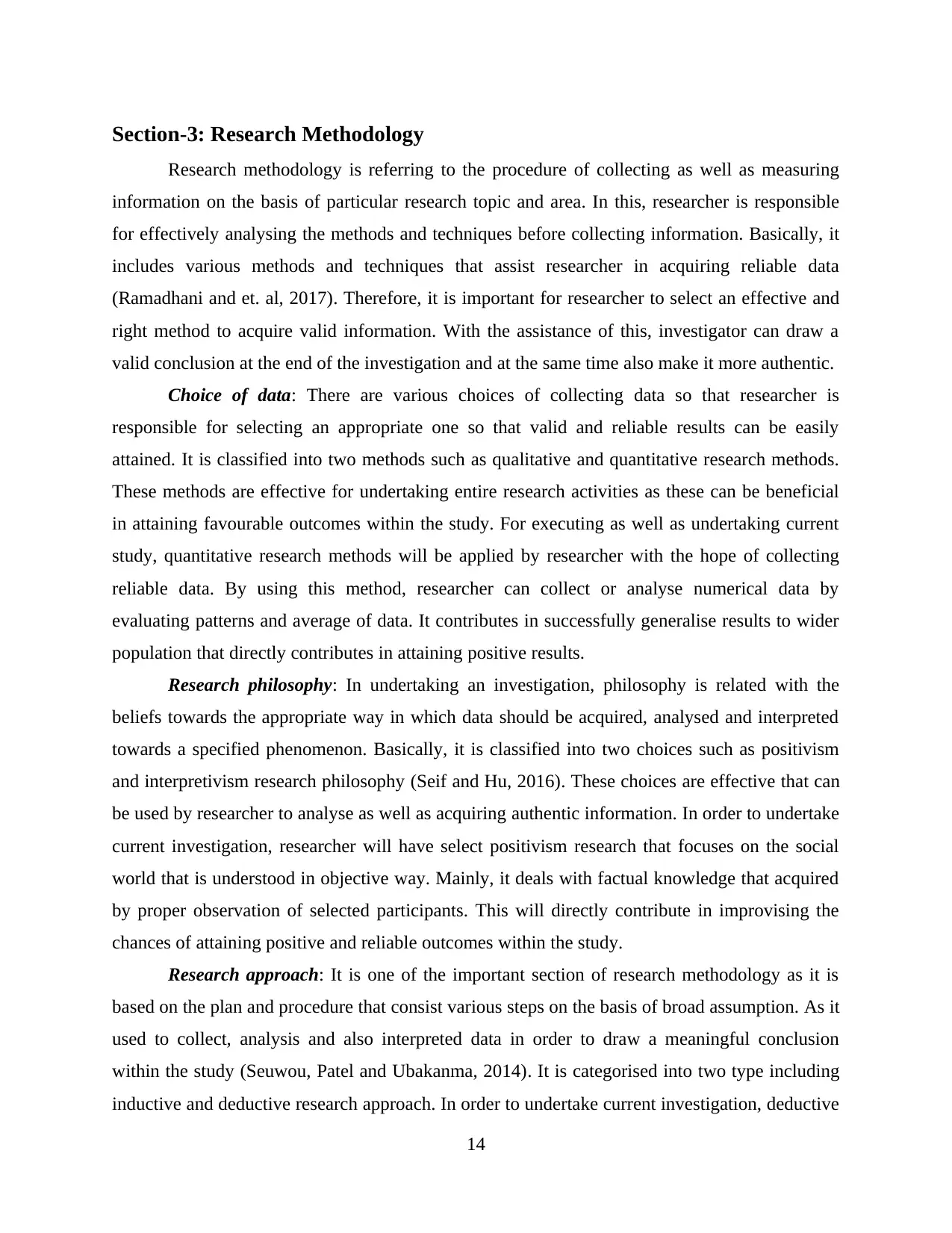
Research methodology is referring to the procedure of collecting as well as measuring
information on the basis of particular research topic and area. In this, researcher is responsible
for effectively analysing the methods and techniques before collecting information. Basically, it
includes various methods and techniques that assist researcher in acquiring reliable data
(Ramadhani and et. al, 2017). Therefore, it is important for researcher to select an effective and
right method to acquire valid information. With the assistance of this, investigator can draw a
valid conclusion at the end of the investigation and at the same time also make it more authentic.
Choice of data: There are various choices of collecting data so that researcher is
responsible for selecting an appropriate one so that valid and reliable results can be easily
attained. It is classified into two methods such as qualitative and quantitative research methods.
These methods are effective for undertaking entire research activities as these can be beneficial
in attaining favourable outcomes within the study. For executing as well as undertaking current
study, quantitative research methods will be applied by researcher with the hope of collecting
reliable data. By using this method, researcher can collect or analyse numerical data by
evaluating patterns and average of data. It contributes in successfully generalise results to wider
population that directly contributes in attaining positive results.
Research philosophy: In undertaking an investigation, philosophy is related with the
beliefs towards the appropriate way in which data should be acquired, analysed and interpreted
towards a specified phenomenon. Basically, it is classified into two choices such as positivism
and interpretivism research philosophy (Seif and Hu, 2016). These choices are effective that can
be used by researcher to analyse as well as acquiring authentic information. In order to undertake
current investigation, researcher will have select positivism research that focuses on the social
world that is understood in objective way. Mainly, it deals with factual knowledge that acquired
by proper observation of selected participants. This will directly contribute in improvising the
chances of attaining positive and reliable outcomes within the study.
Research approach: It is one of the important section of research methodology as it is
based on the plan and procedure that consist various steps on the basis of broad assumption. As it
used to collect, analysis and also interpreted data in order to draw a meaningful conclusion
within the study (Seuwou, Patel and Ubakanma, 2014). It is categorised into two type including
inductive and deductive research approach. In order to undertake current investigation, deductive
14
Paraphrase This Document
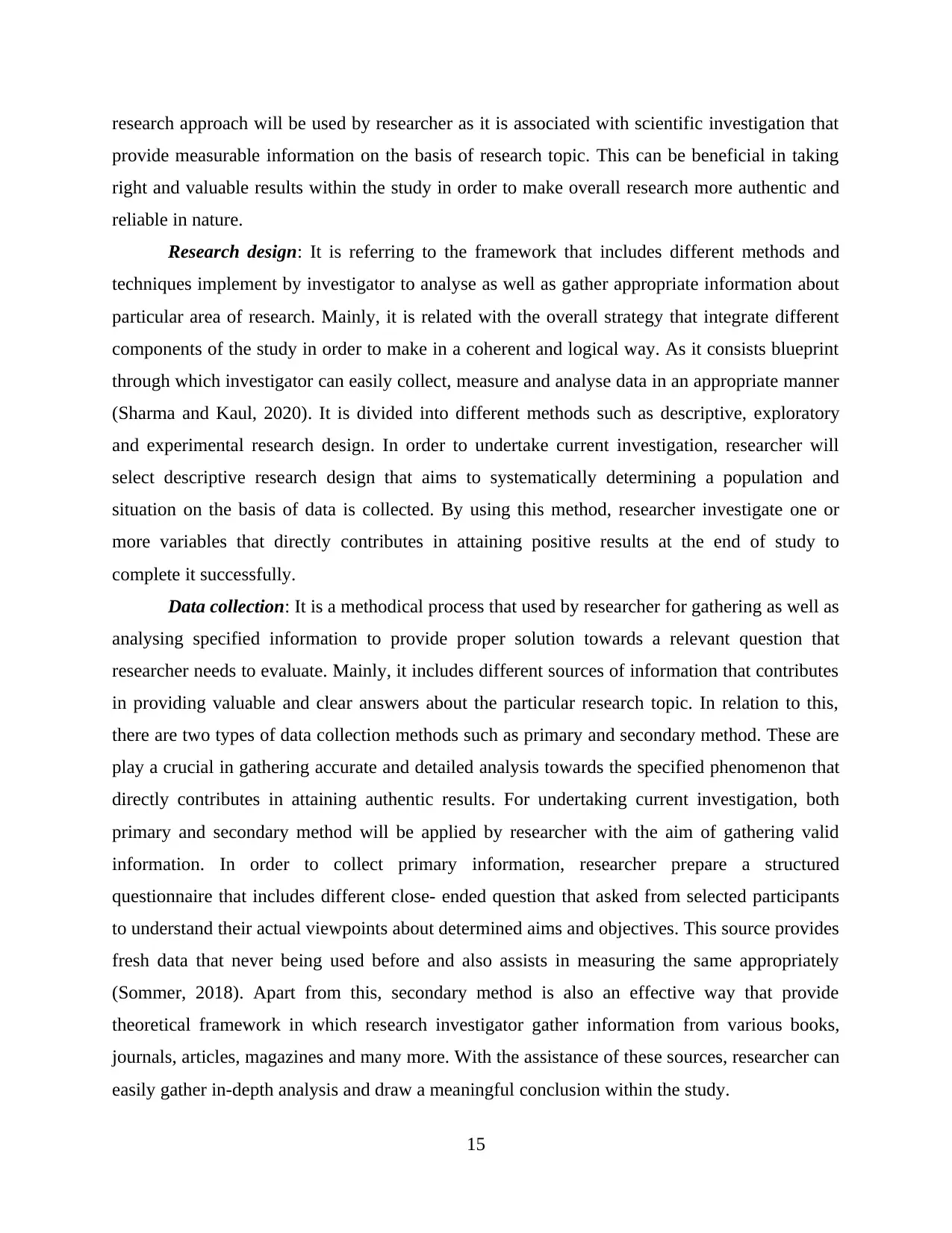
provide measurable information on the basis of research topic. This can be beneficial in taking
right and valuable results within the study in order to make overall research more authentic and
reliable in nature.
Research design: It is referring to the framework that includes different methods and
techniques implement by investigator to analyse as well as gather appropriate information about
particular area of research. Mainly, it is related with the overall strategy that integrate different
components of the study in order to make in a coherent and logical way. As it consists blueprint
through which investigator can easily collect, measure and analyse data in an appropriate manner
(Sharma and Kaul, 2020). It is divided into different methods such as descriptive, exploratory
and experimental research design. In order to undertake current investigation, researcher will
select descriptive research design that aims to systematically determining a population and
situation on the basis of data is collected. By using this method, researcher investigate one or
more variables that directly contributes in attaining positive results at the end of study to
complete it successfully.
Data collection: It is a methodical process that used by researcher for gathering as well as
analysing specified information to provide proper solution towards a relevant question that
researcher needs to evaluate. Mainly, it includes different sources of information that contributes
in providing valuable and clear answers about the particular research topic. In relation to this,
there are two types of data collection methods such as primary and secondary method. These are
play a crucial in gathering accurate and detailed analysis towards the specified phenomenon that
directly contributes in attaining authentic results. For undertaking current investigation, both
primary and secondary method will be applied by researcher with the aim of gathering valid
information. In order to collect primary information, researcher prepare a structured
questionnaire that includes different close- ended question that asked from selected participants
to understand their actual viewpoints about determined aims and objectives. This source provides
fresh data that never being used before and also assists in measuring the same appropriately
(Sommer, 2018). Apart from this, secondary method is also an effective way that provide
theoretical framework in which research investigator gather information from various books,
journals, articles, magazines and many more. With the assistance of these sources, researcher can
easily gather in-depth analysis and draw a meaningful conclusion within the study.
15
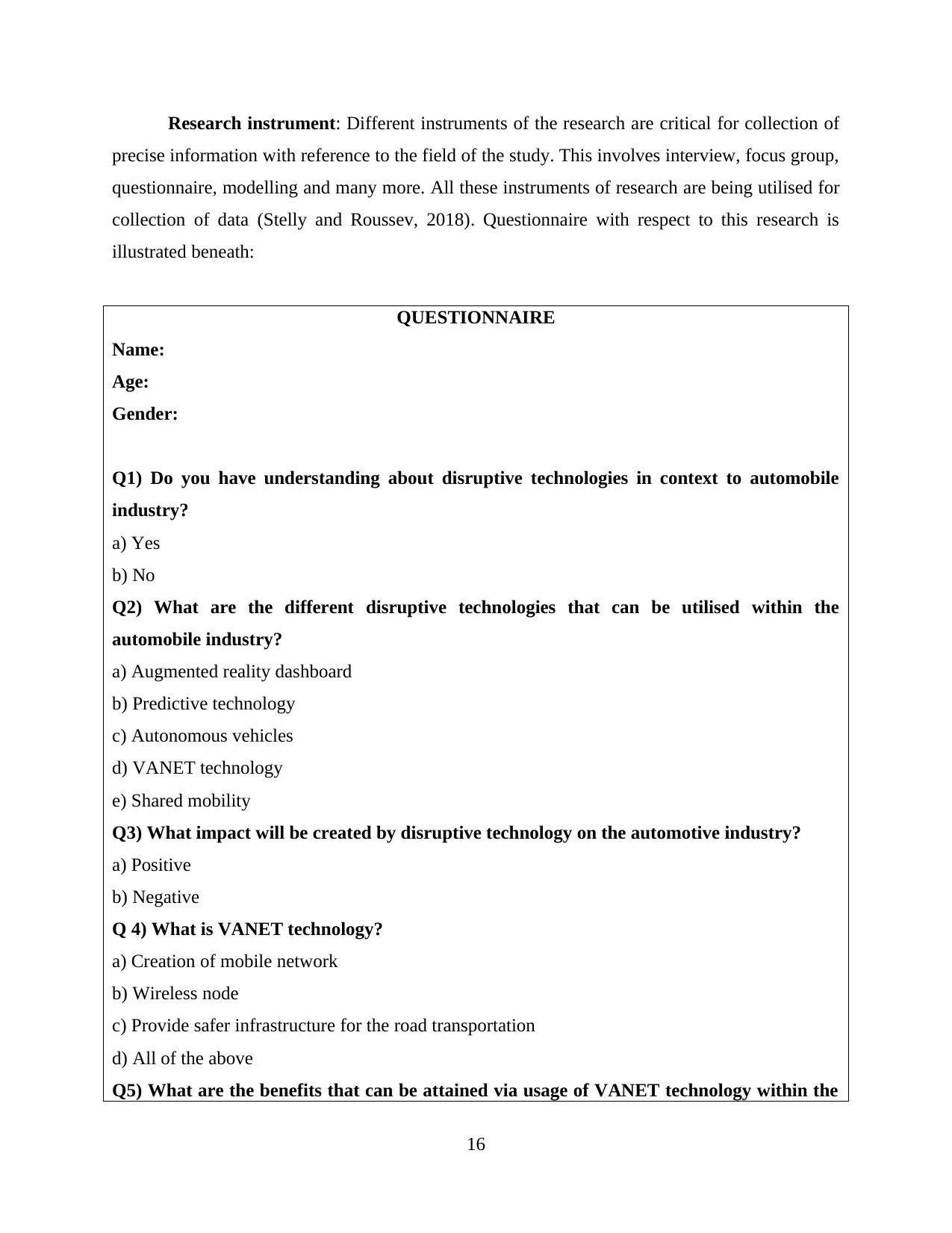
precise information with reference to the field of the study. This involves interview, focus group,
questionnaire, modelling and many more. All these instruments of research are being utilised for
collection of data (Stelly and Roussev, 2018). Questionnaire with respect to this research is
illustrated beneath:
QUESTIONNAIRE
Name:
Age:
Gender:
Q1) Do you have understanding about disruptive technologies in context to automobile
industry?
a) Yes
b) No
Q2) What are the different disruptive technologies that can be utilised within the
automobile industry?
a) Augmented reality dashboard
b) Predictive technology
c) Autonomous vehicles
d) VANET technology
e) Shared mobility
Q3) What impact will be created by disruptive technology on the automotive industry?
a) Positive
b) Negative
Q 4) What is VANET technology?
a) Creation of mobile network
b) Wireless node
c) Provide safer infrastructure for the road transportation
d) All of the above
Q5) What are the benefits that can be attained via usage of VANET technology within the
16
You're viewing a preview
Unlock full access by subscribing today!
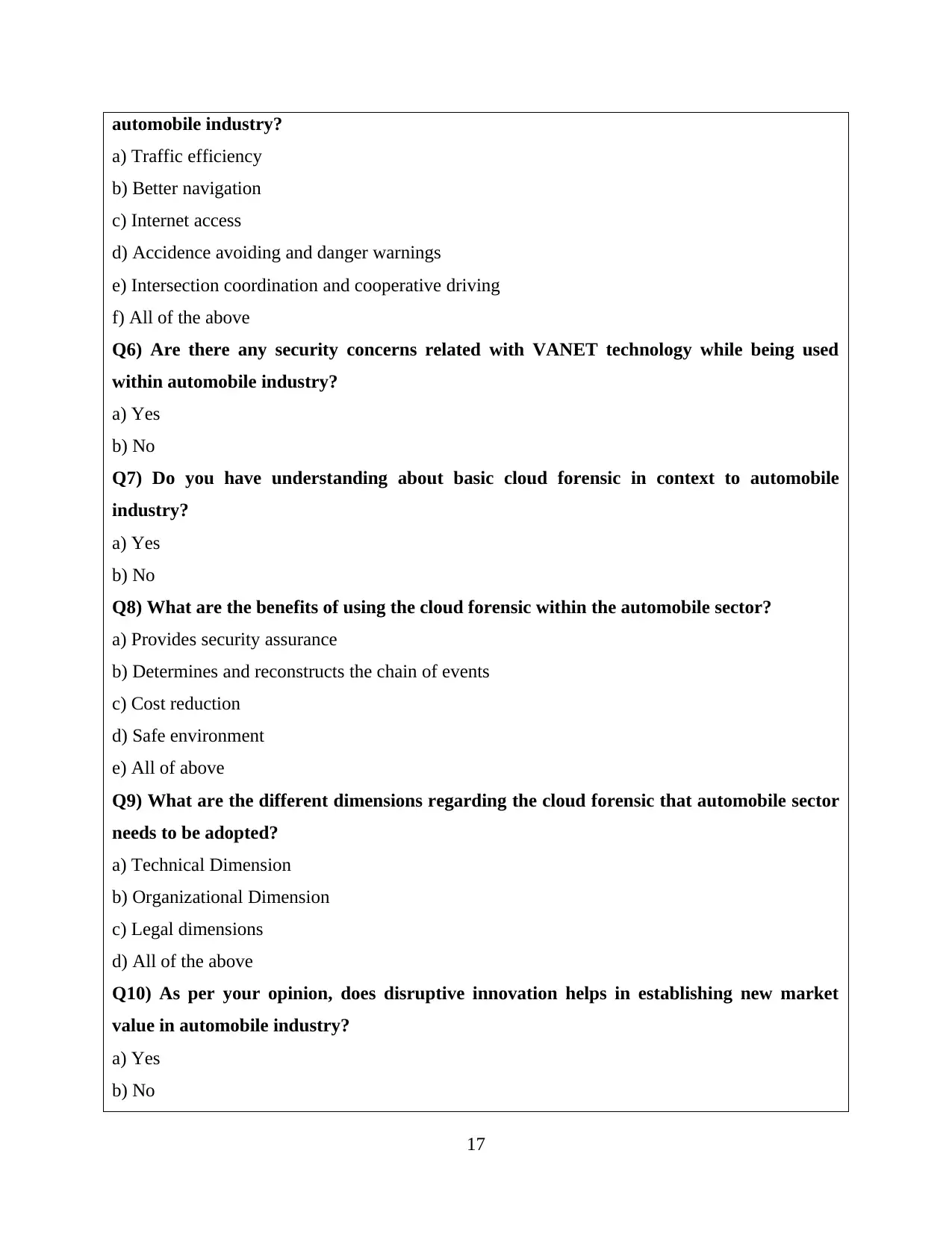
a) Traffic efficiency
b) Better navigation
c) Internet access
d) Accidence avoiding and danger warnings
e) Intersection coordination and cooperative driving
f) All of the above
Q6) Are there any security concerns related with VANET technology while being used
within automobile industry?
a) Yes
b) No
Q7) Do you have understanding about basic cloud forensic in context to automobile
industry?
a) Yes
b) No
Q8) What are the benefits of using the cloud forensic within the automobile sector?
a) Provides security assurance
b) Determines and reconstructs the chain of events
c) Cost reduction
d) Safe environment
e) All of above
Q9) What are the different dimensions regarding the cloud forensic that automobile sector
needs to be adopted?
a) Technical Dimension
b) Organizational Dimension
c) Legal dimensions
d) All of the above
Q10) As per your opinion, does disruptive innovation helps in establishing new market
value in automobile industry?
a) Yes
b) No
17
Paraphrase This Document
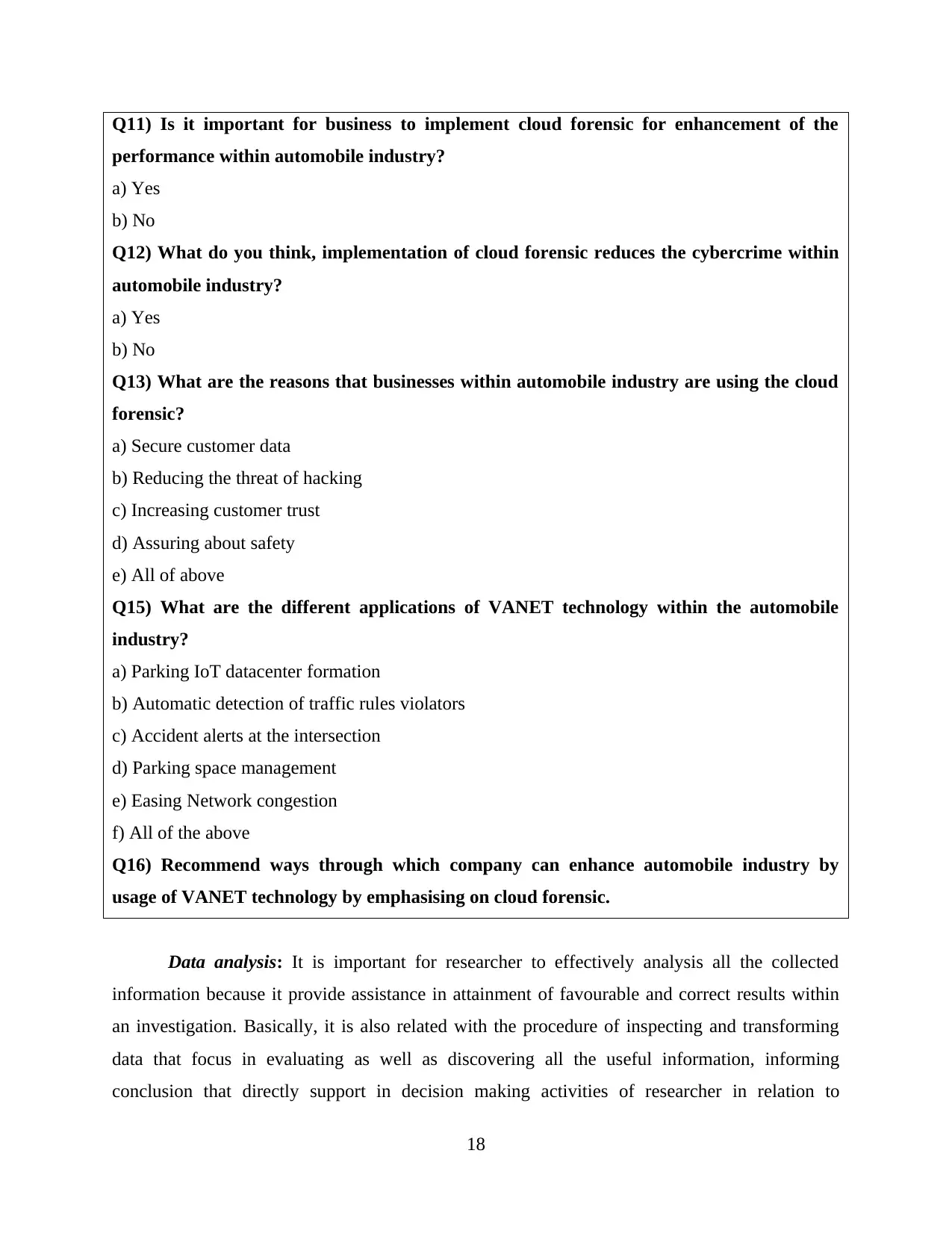
performance within automobile industry?
a) Yes
b) No
Q12) What do you think, implementation of cloud forensic reduces the cybercrime within
automobile industry?
a) Yes
b) No
Q13) What are the reasons that businesses within automobile industry are using the cloud
forensic?
a) Secure customer data
b) Reducing the threat of hacking
c) Increasing customer trust
d) Assuring about safety
e) All of above
Q15) What are the different applications of VANET technology within the automobile
industry?
a) Parking IoT datacenter formation
b) Automatic detection of traffic rules violators
c) Accident alerts at the intersection
d) Parking space management
e) Easing Network congestion
f) All of the above
Q16) Recommend ways through which company can enhance automobile industry by
usage of VANET technology by emphasising on cloud forensic.
Data analysis: It is important for researcher to effectively analysis all the collected
information because it provide assistance in attainment of favourable and correct results within
an investigation. Basically, it is also related with the procedure of inspecting and transforming
data that focus in evaluating as well as discovering all the useful information, informing
conclusion that directly support in decision making activities of researcher in relation to
18
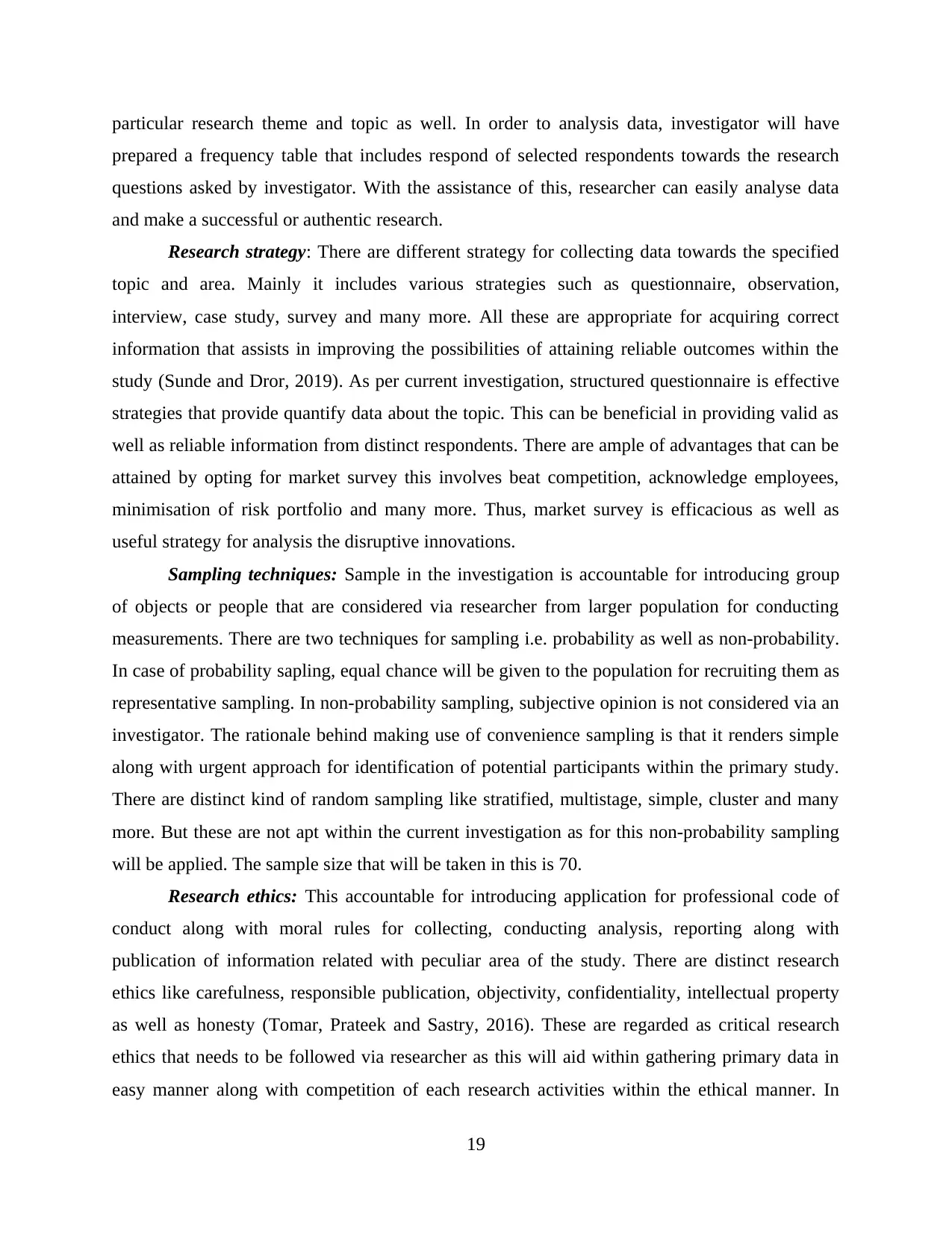
prepared a frequency table that includes respond of selected respondents towards the research
questions asked by investigator. With the assistance of this, researcher can easily analyse data
and make a successful or authentic research.
Research strategy: There are different strategy for collecting data towards the specified
topic and area. Mainly it includes various strategies such as questionnaire, observation,
interview, case study, survey and many more. All these are appropriate for acquiring correct
information that assists in improving the possibilities of attaining reliable outcomes within the
study (Sunde and Dror, 2019). As per current investigation, structured questionnaire is effective
strategies that provide quantify data about the topic. This can be beneficial in providing valid as
well as reliable information from distinct respondents. There are ample of advantages that can be
attained by opting for market survey this involves beat competition, acknowledge employees,
minimisation of risk portfolio and many more. Thus, market survey is efficacious as well as
useful strategy for analysis the disruptive innovations.
Sampling techniques: Sample in the investigation is accountable for introducing group
of objects or people that are considered via researcher from larger population for conducting
measurements. There are two techniques for sampling i.e. probability as well as non-probability.
In case of probability sapling, equal chance will be given to the population for recruiting them as
representative sampling. In non-probability sampling, subjective opinion is not considered via an
investigator. The rationale behind making use of convenience sampling is that it renders simple
along with urgent approach for identification of potential participants within the primary study.
There are distinct kind of random sampling like stratified, multistage, simple, cluster and many
more. But these are not apt within the current investigation as for this non-probability sampling
will be applied. The sample size that will be taken in this is 70.
Research ethics: This accountable for introducing application for professional code of
conduct along with moral rules for collecting, conducting analysis, reporting along with
publication of information related with peculiar area of the study. There are distinct research
ethics like carefulness, responsible publication, objectivity, confidentiality, intellectual property
as well as honesty (Tomar, Prateek and Sastry, 2016). These are regarded as critical research
ethics that needs to be followed via researcher as this will aid within gathering primary data in
easy manner along with competition of each research activities within the ethical manner. In
19
You're viewing a preview
Unlock full access by subscribing today!
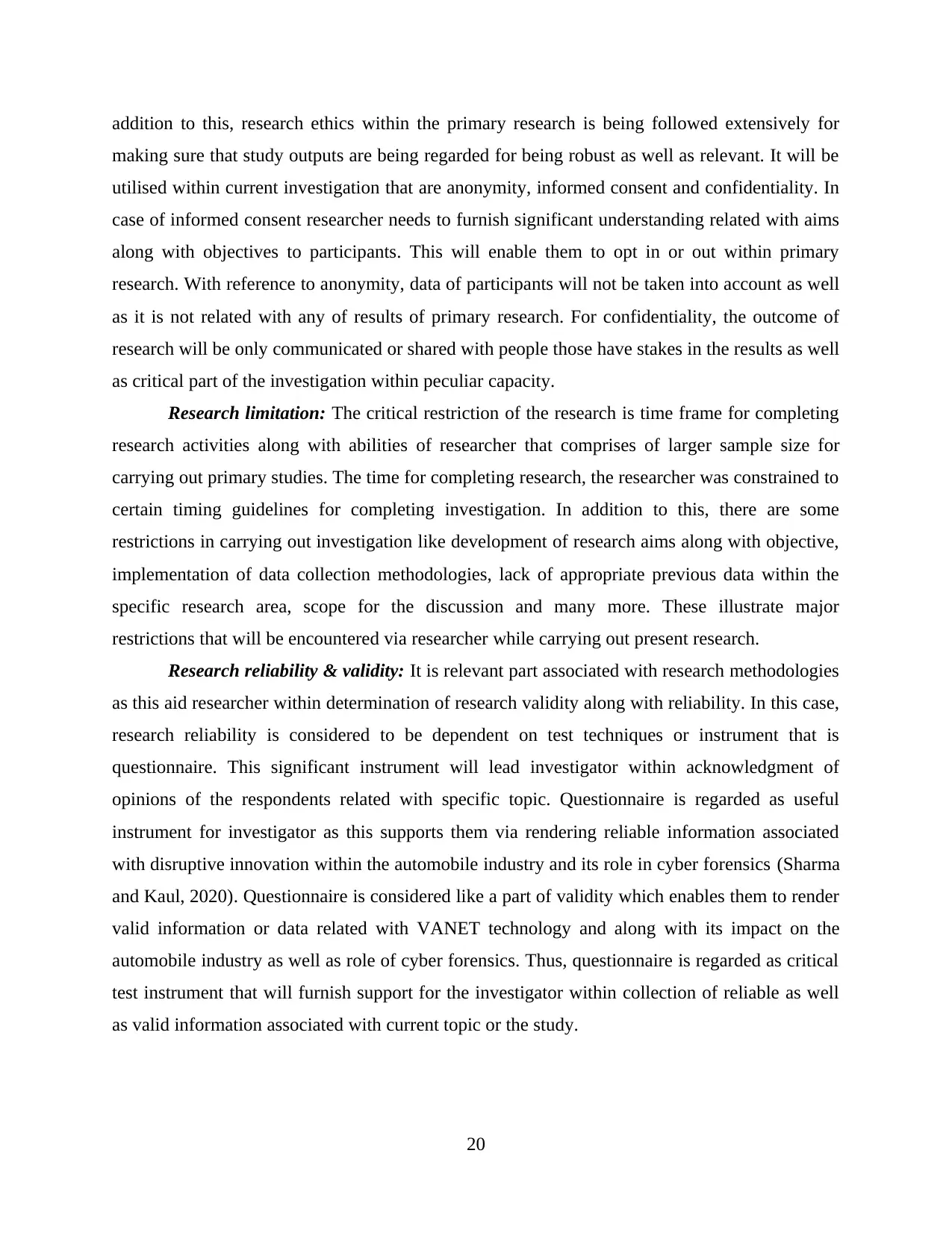
making sure that study outputs are being regarded for being robust as well as relevant. It will be
utilised within current investigation that are anonymity, informed consent and confidentiality. In
case of informed consent researcher needs to furnish significant understanding related with aims
along with objectives to participants. This will enable them to opt in or out within primary
research. With reference to anonymity, data of participants will not be taken into account as well
as it is not related with any of results of primary research. For confidentiality, the outcome of
research will be only communicated or shared with people those have stakes in the results as well
as critical part of the investigation within peculiar capacity.
Research limitation: The critical restriction of the research is time frame for completing
research activities along with abilities of researcher that comprises of larger sample size for
carrying out primary studies. The time for completing research, the researcher was constrained to
certain timing guidelines for completing investigation. In addition to this, there are some
restrictions in carrying out investigation like development of research aims along with objective,
implementation of data collection methodologies, lack of appropriate previous data within the
specific research area, scope for the discussion and many more. These illustrate major
restrictions that will be encountered via researcher while carrying out present research.
Research reliability & validity: It is relevant part associated with research methodologies
as this aid researcher within determination of research validity along with reliability. In this case,
research reliability is considered to be dependent on test techniques or instrument that is
questionnaire. This significant instrument will lead investigator within acknowledgment of
opinions of the respondents related with specific topic. Questionnaire is regarded as useful
instrument for investigator as this supports them via rendering reliable information associated
with disruptive innovation within the automobile industry and its role in cyber forensics (Sharma
and Kaul, 2020). Questionnaire is considered like a part of validity which enables them to render
valid information or data related with VANET technology and along with its impact on the
automobile industry as well as role of cyber forensics. Thus, questionnaire is regarded as critical
test instrument that will furnish support for the investigator within collection of reliable as well
as valid information associated with current topic or the study.
20
Paraphrase This Document
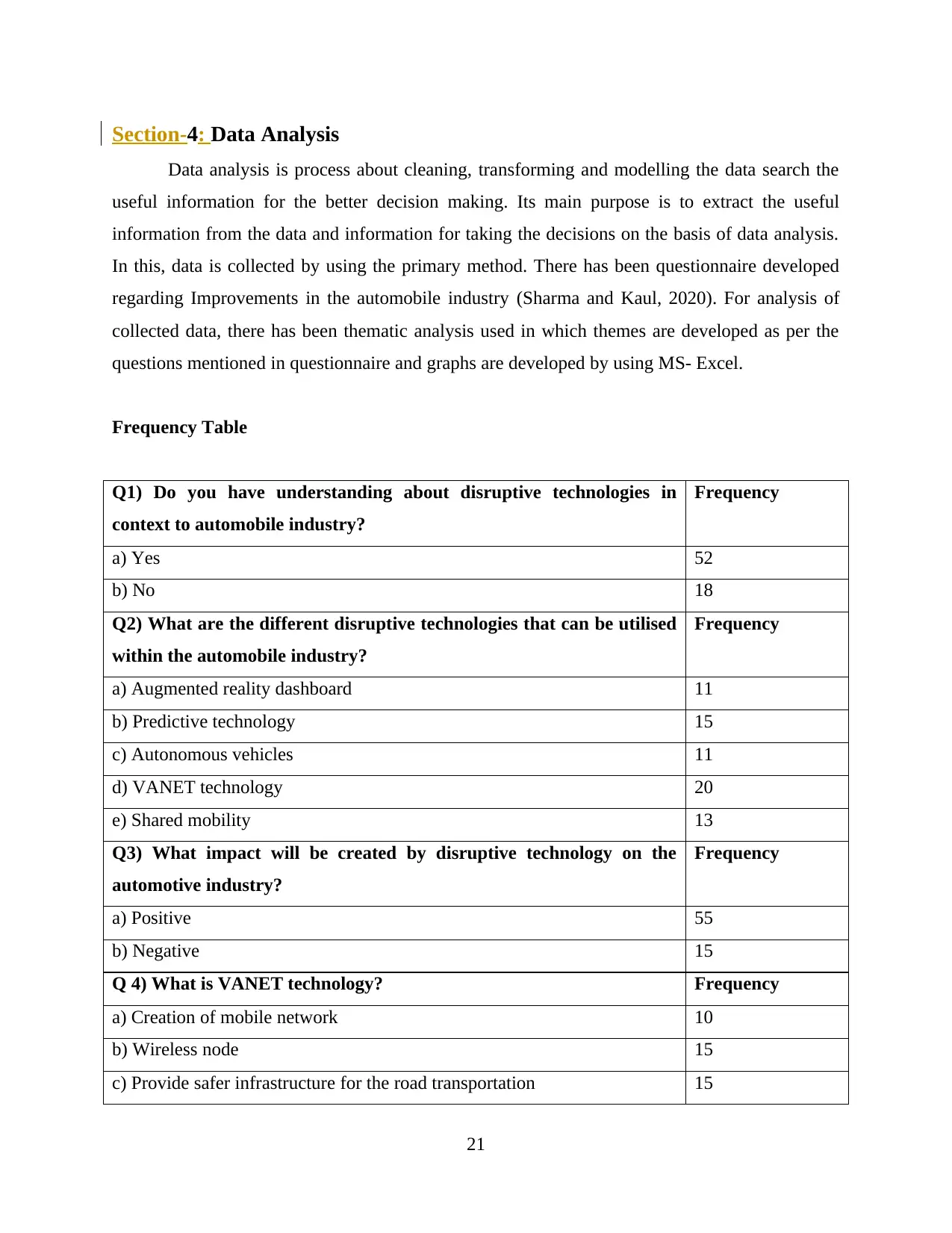
Data analysis is process about cleaning, transforming and modelling the data search the
useful information for the better decision making. Its main purpose is to extract the useful
information from the data and information for taking the decisions on the basis of data analysis.
In this, data is collected by using the primary method. There has been questionnaire developed
regarding Improvements in the automobile industry (Sharma and Kaul, 2020). For analysis of
collected data, there has been thematic analysis used in which themes are developed as per the
questions mentioned in questionnaire and graphs are developed by using MS- Excel.
Frequency Table
Q1) Do you have understanding about disruptive technologies in
context to automobile industry?
Frequency
a) Yes 52
b) No 18
Q2) What are the different disruptive technologies that can be utilised
within the automobile industry?
Frequency
a) Augmented reality dashboard 11
b) Predictive technology 15
c) Autonomous vehicles 11
d) VANET technology 20
e) Shared mobility 13
Q3) What impact will be created by disruptive technology on the
automotive industry?
Frequency
a) Positive 55
b) Negative 15
Q 4) What is VANET technology? Frequency
a) Creation of mobile network 10
b) Wireless node 15
c) Provide safer infrastructure for the road transportation 15
21
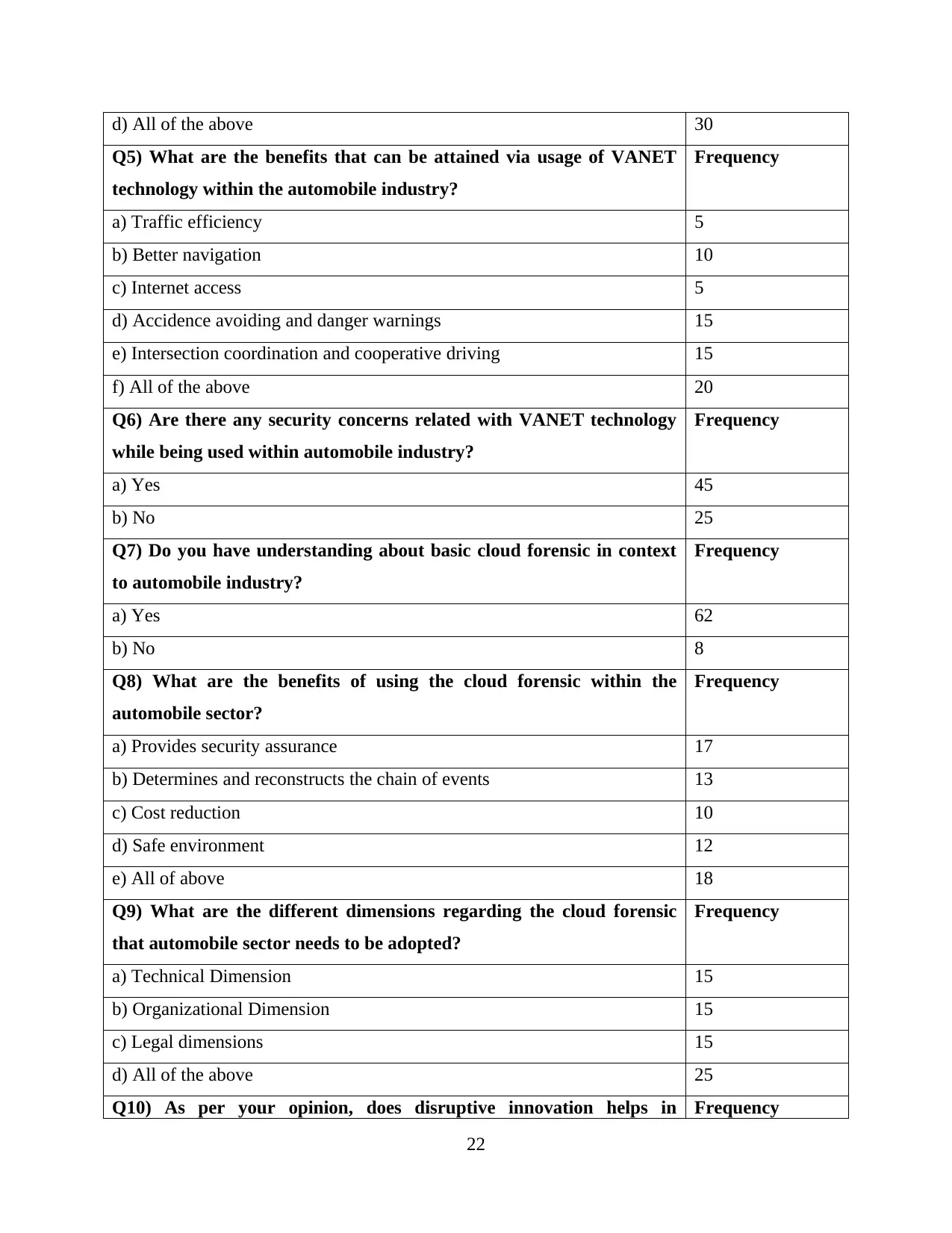
Q5) What are the benefits that can be attained via usage of VANET
technology within the automobile industry?
Frequency
a) Traffic efficiency 5
b) Better navigation 10
c) Internet access 5
d) Accidence avoiding and danger warnings 15
e) Intersection coordination and cooperative driving 15
f) All of the above 20
Q6) Are there any security concerns related with VANET technology
while being used within automobile industry?
Frequency
a) Yes 45
b) No 25
Q7) Do you have understanding about basic cloud forensic in context
to automobile industry?
Frequency
a) Yes 62
b) No 8
Q8) What are the benefits of using the cloud forensic within the
automobile sector?
Frequency
a) Provides security assurance 17
b) Determines and reconstructs the chain of events 13
c) Cost reduction 10
d) Safe environment 12
e) All of above 18
Q9) What are the different dimensions regarding the cloud forensic
that automobile sector needs to be adopted?
Frequency
a) Technical Dimension 15
b) Organizational Dimension 15
c) Legal dimensions 15
d) All of the above 25
Q10) As per your opinion, does disruptive innovation helps in Frequency
22
You're viewing a preview
Unlock full access by subscribing today!
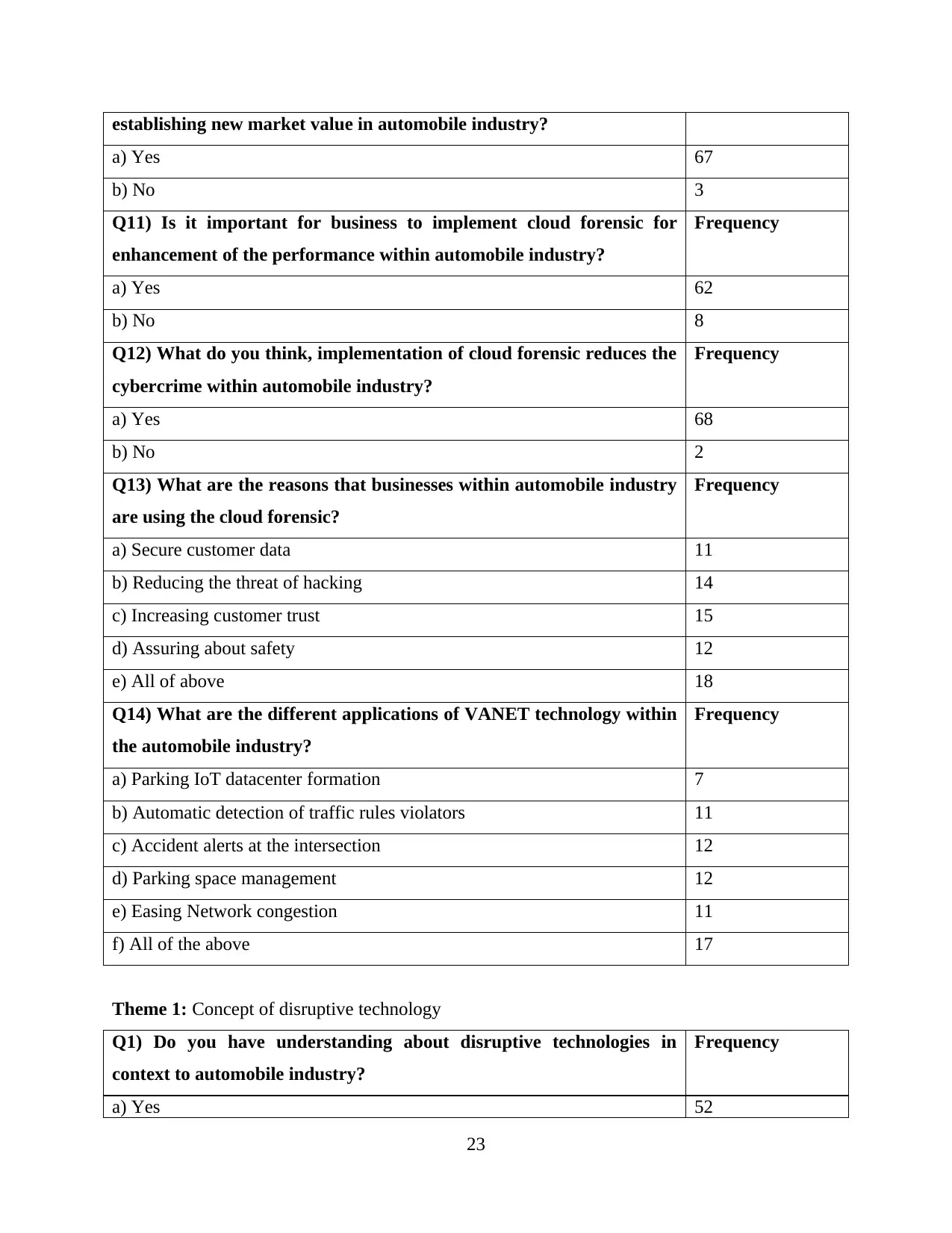
a) Yes 67
b) No 3
Q11) Is it important for business to implement cloud forensic for
enhancement of the performance within automobile industry?
Frequency
a) Yes 62
b) No 8
Q12) What do you think, implementation of cloud forensic reduces the
cybercrime within automobile industry?
Frequency
a) Yes 68
b) No 2
Q13) What are the reasons that businesses within automobile industry
are using the cloud forensic?
Frequency
a) Secure customer data 11
b) Reducing the threat of hacking 14
c) Increasing customer trust 15
d) Assuring about safety 12
e) All of above 18
Q14) What are the different applications of VANET technology within
the automobile industry?
Frequency
a) Parking IoT datacenter formation 7
b) Automatic detection of traffic rules violators 11
c) Accident alerts at the intersection 12
d) Parking space management 12
e) Easing Network congestion 11
f) All of the above 17
Theme 1: Concept of disruptive technology
Q1) Do you have understanding about disruptive technologies in
context to automobile industry?
Frequency
a) Yes 52
23
Paraphrase This Document
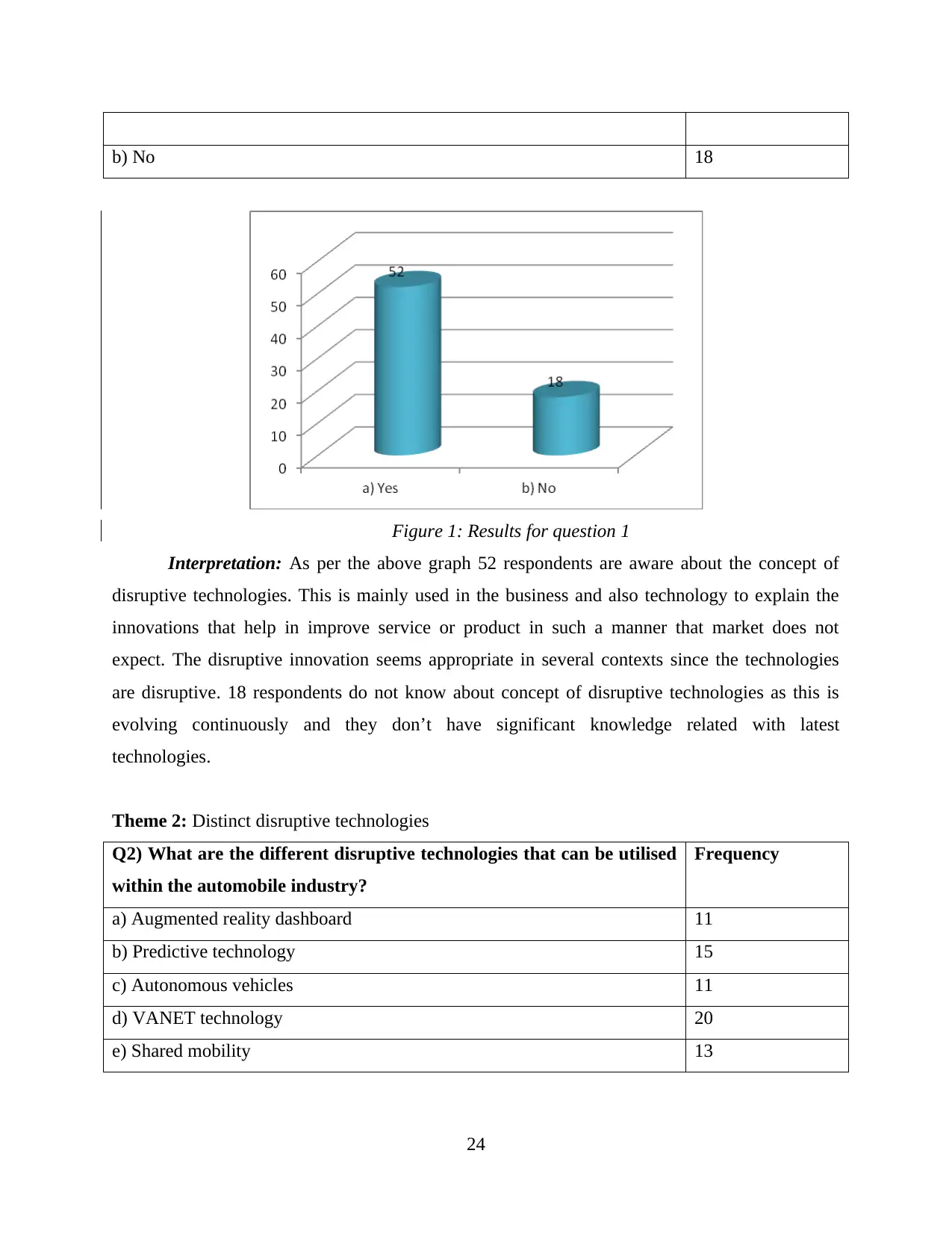
Figure 1: Results for question 1
Interpretation: As per the above graph 52 respondents are aware about the concept of
disruptive technologies. This is mainly used in the business and also technology to explain the
innovations that help in improve service or product in such a manner that market does not
expect. The disruptive innovation seems appropriate in several contexts since the technologies
are disruptive. 18 respondents do not know about concept of disruptive technologies as this is
evolving continuously and they don’t have significant knowledge related with latest
technologies.
Theme 2: Distinct disruptive technologies
Q2) What are the different disruptive technologies that can be utilised
within the automobile industry?
Frequency
a) Augmented reality dashboard 11
b) Predictive technology 15
c) Autonomous vehicles 11
d) VANET technology 20
e) Shared mobility 13
24
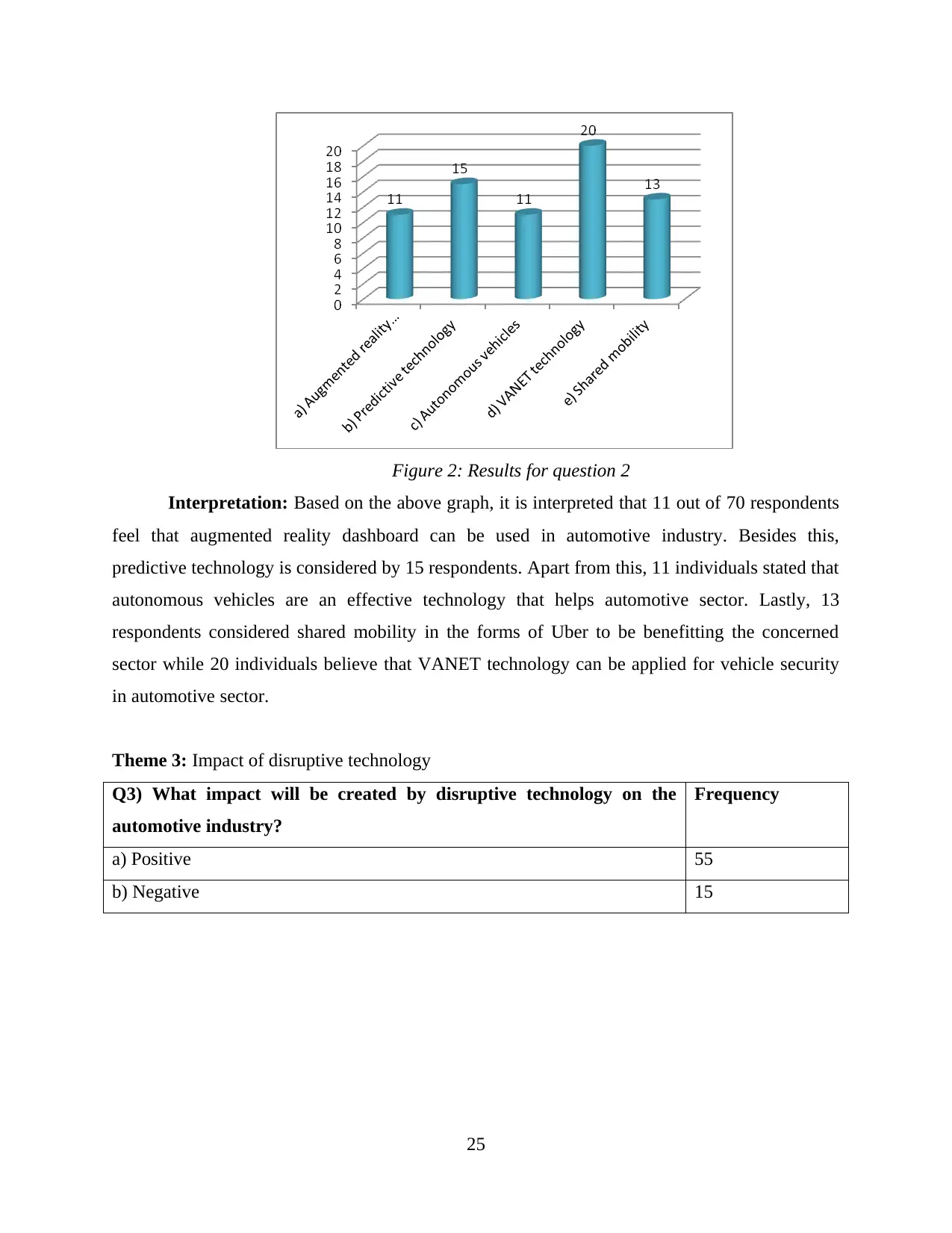
Interpretation: Based on the above graph, it is interpreted that 11 out of 70 respondents
feel that augmented reality dashboard can be used in automotive industry. Besides this,
predictive technology is considered by 15 respondents. Apart from this, 11 individuals stated that
autonomous vehicles are an effective technology that helps automotive sector. Lastly, 13
respondents considered shared mobility in the forms of Uber to be benefitting the concerned
sector while 20 individuals believe that VANET technology can be applied for vehicle security
in automotive sector.
Theme 3: Impact of disruptive technology
Q3) What impact will be created by disruptive technology on the
automotive industry?
Frequency
a) Positive 55
b) Negative 15
25
You're viewing a preview
Unlock full access by subscribing today!
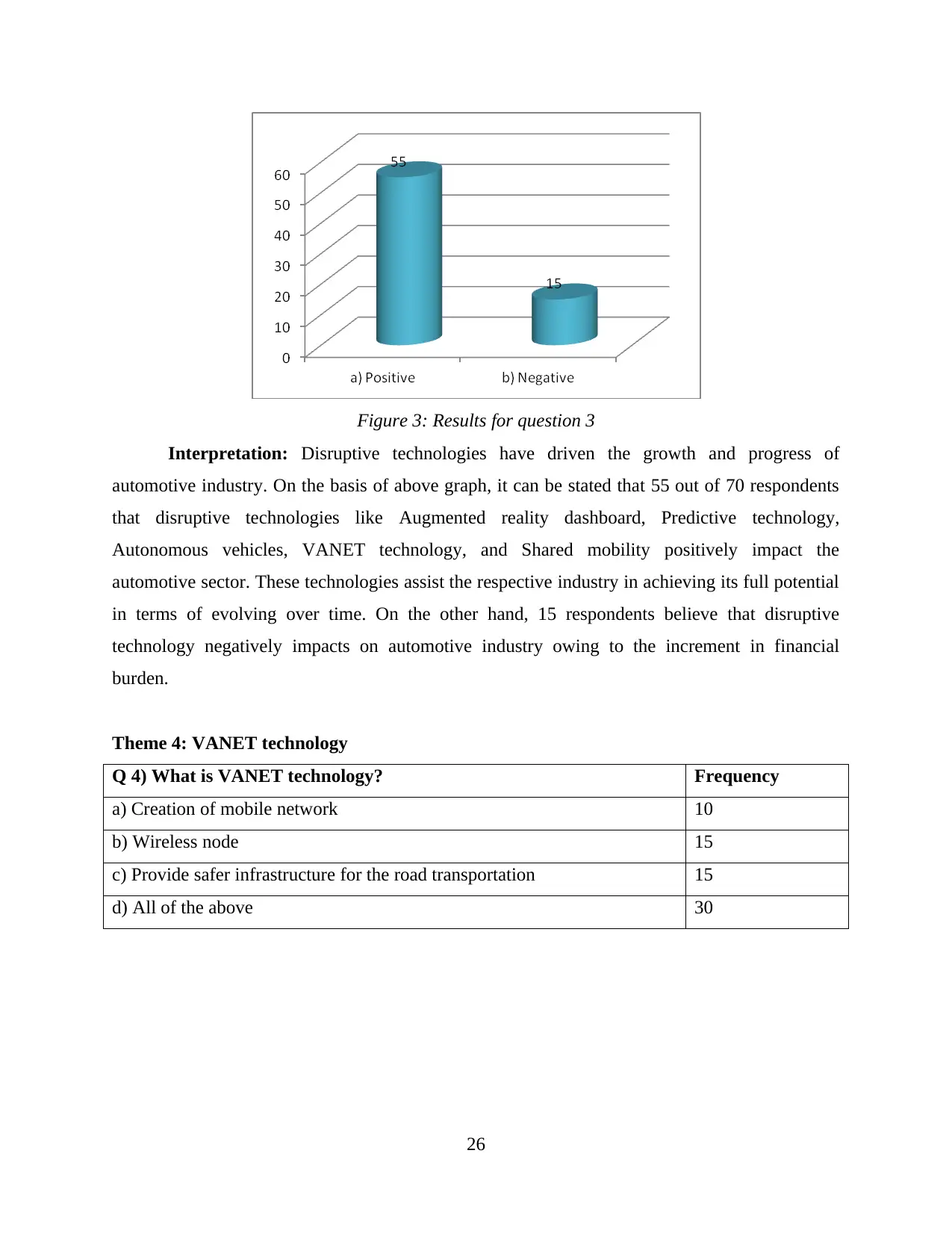
Interpretation: Disruptive technologies have driven the growth and progress of
automotive industry. On the basis of above graph, it can be stated that 55 out of 70 respondents
that disruptive technologies like Augmented reality dashboard, Predictive technology,
Autonomous vehicles, VANET technology, and Shared mobility positively impact the
automotive sector. These technologies assist the respective industry in achieving its full potential
in terms of evolving over time. On the other hand, 15 respondents believe that disruptive
technology negatively impacts on automotive industry owing to the increment in financial
burden.
Theme 4: VANET technology
Q 4) What is VANET technology? Frequency
a) Creation of mobile network 10
b) Wireless node 15
c) Provide safer infrastructure for the road transportation 15
d) All of the above 30
26
Paraphrase This Document
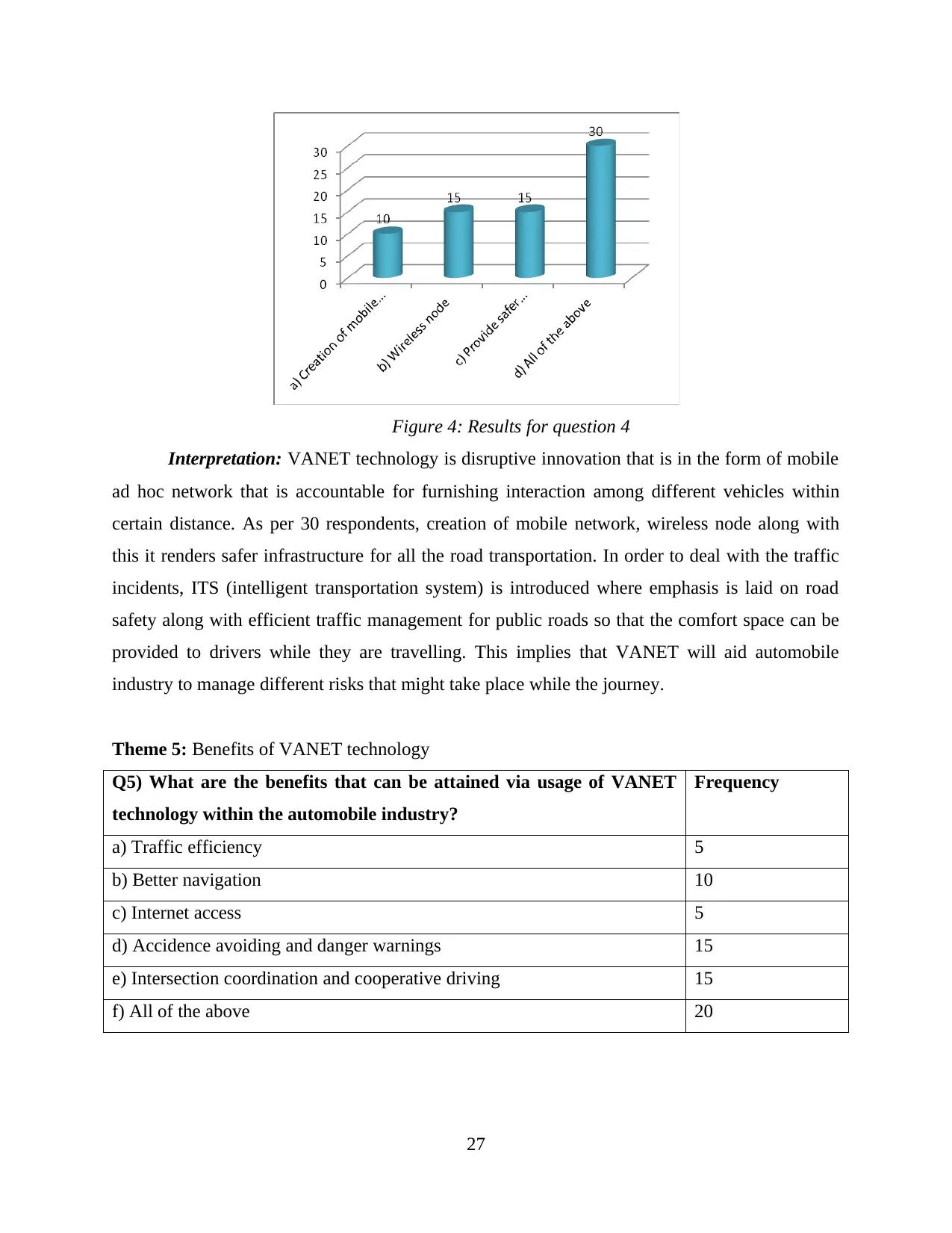
Interpretation: VANET technology is disruptive innovation that is in the form of mobile
ad hoc network that is accountable for furnishing interaction among different vehicles within
certain distance. As per 30 respondents, creation of mobile network, wireless node along with
this it renders safer infrastructure for all the road transportation. In order to deal with the traffic
incidents, ITS (intelligent transportation system) is introduced where emphasis is laid on road
safety along with efficient traffic management for public roads so that the comfort space can be
provided to drivers while they are travelling. This implies that VANET will aid automobile
industry to manage different risks that might take place while the journey.
Theme 5: Benefits of VANET technology
Q5) What are the benefits that can be attained via usage of VANET
technology within the automobile industry?
Frequency
a) Traffic efficiency 5
b) Better navigation 10
c) Internet access 5
d) Accidence avoiding and danger warnings 15
e) Intersection coordination and cooperative driving 15
f) All of the above 20
27
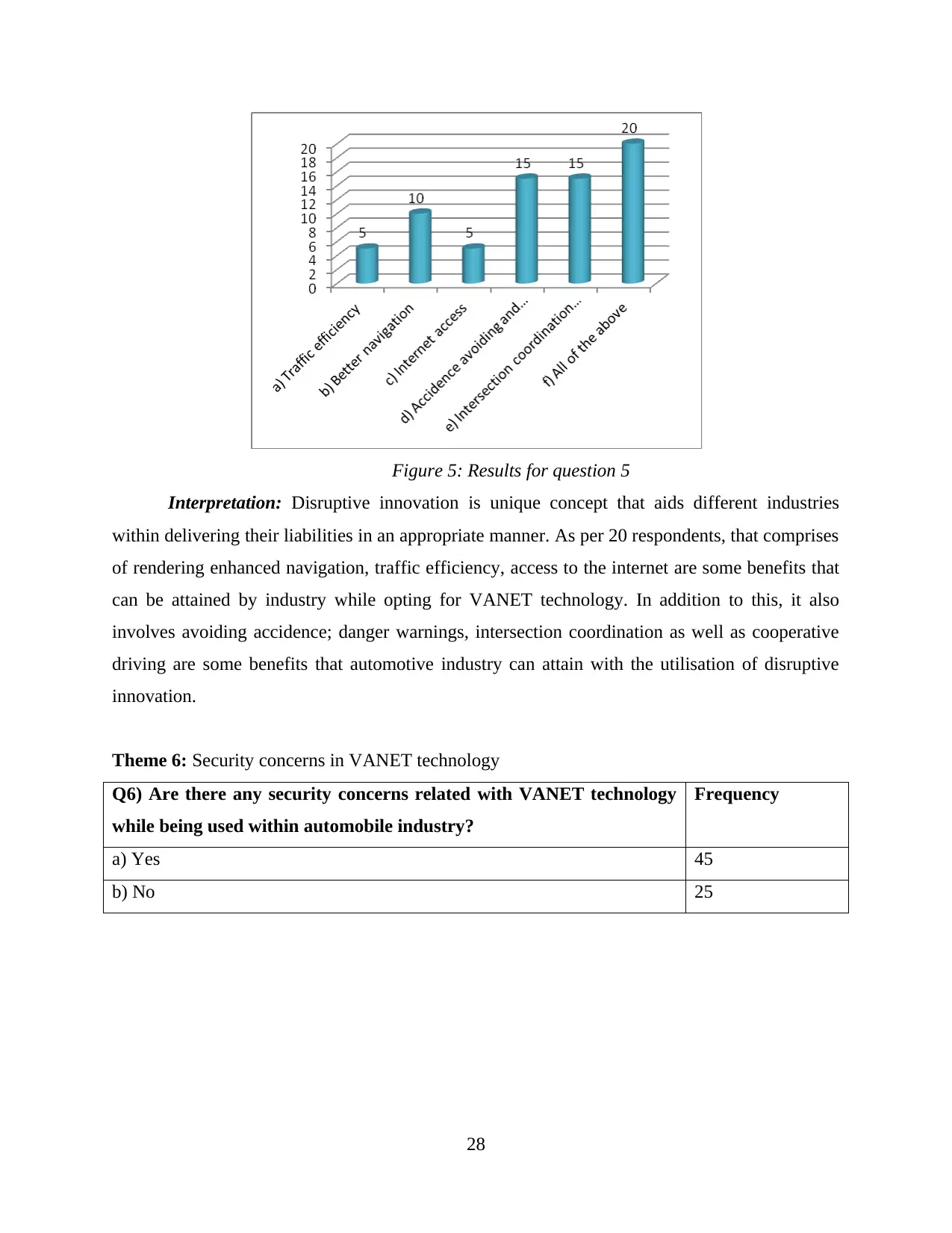
Interpretation: Disruptive innovation is unique concept that aids different industries
within delivering their liabilities in an appropriate manner. As per 20 respondents, that comprises
of rendering enhanced navigation, traffic efficiency, access to the internet are some benefits that
can be attained by industry while opting for VANET technology. In addition to this, it also
involves avoiding accidence; danger warnings, intersection coordination as well as cooperative
driving are some benefits that automotive industry can attain with the utilisation of disruptive
innovation.
Theme 6: Security concerns in VANET technology
Q6) Are there any security concerns related with VANET technology
while being used within automobile industry?
Frequency
a) Yes 45
b) No 25
28
You're viewing a preview
Unlock full access by subscribing today!
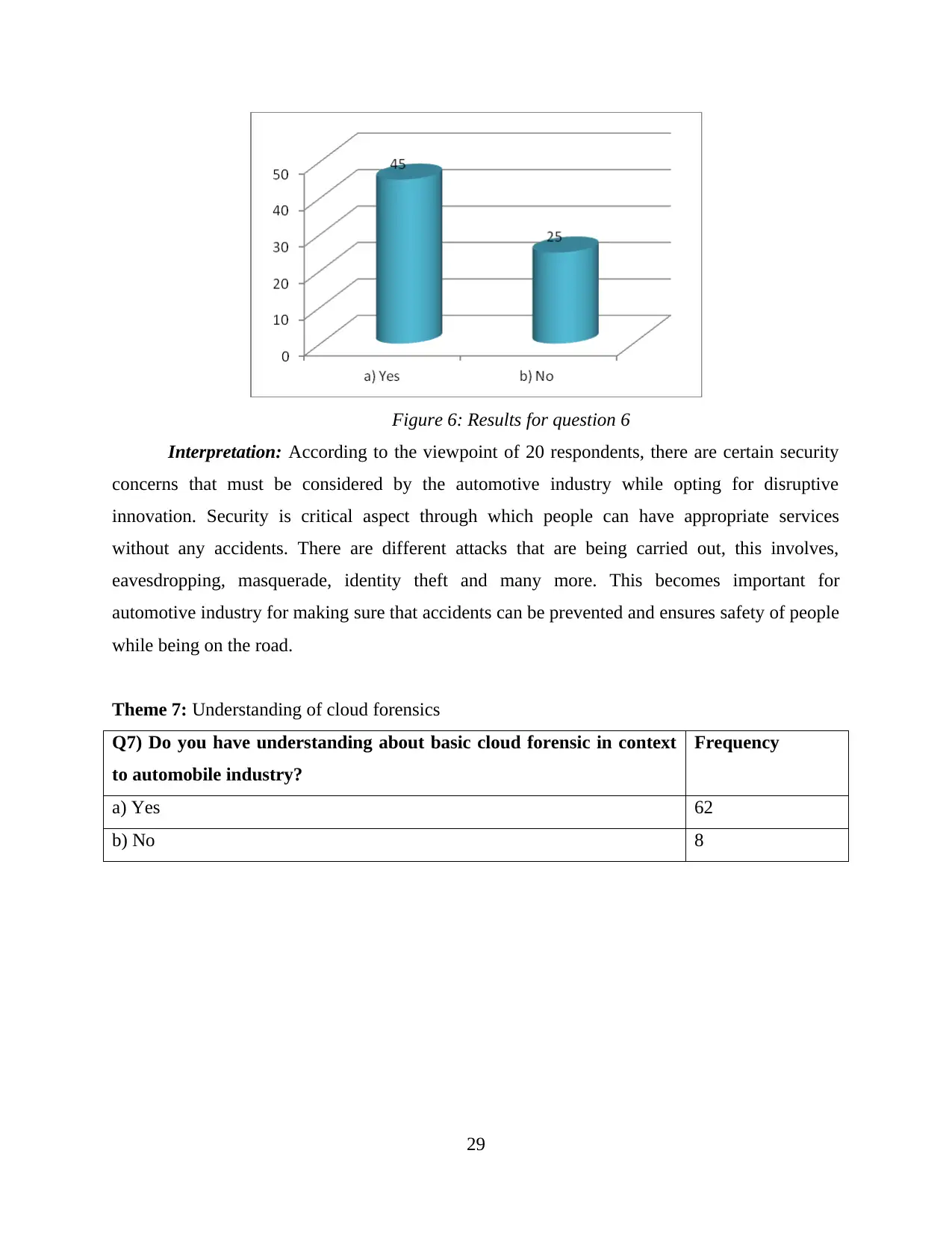
Interpretation: According to the viewpoint of 20 respondents, there are certain security
concerns that must be considered by the automotive industry while opting for disruptive
innovation. Security is critical aspect through which people can have appropriate services
without any accidents. There are different attacks that are being carried out, this involves,
eavesdropping, masquerade, identity theft and many more. This becomes important for
automotive industry for making sure that accidents can be prevented and ensures safety of people
while being on the road.
Theme 7: Understanding of cloud forensics
Q7) Do you have understanding about basic cloud forensic in context
to automobile industry?
Frequency
a) Yes 62
b) No 8
29
Paraphrase This Document
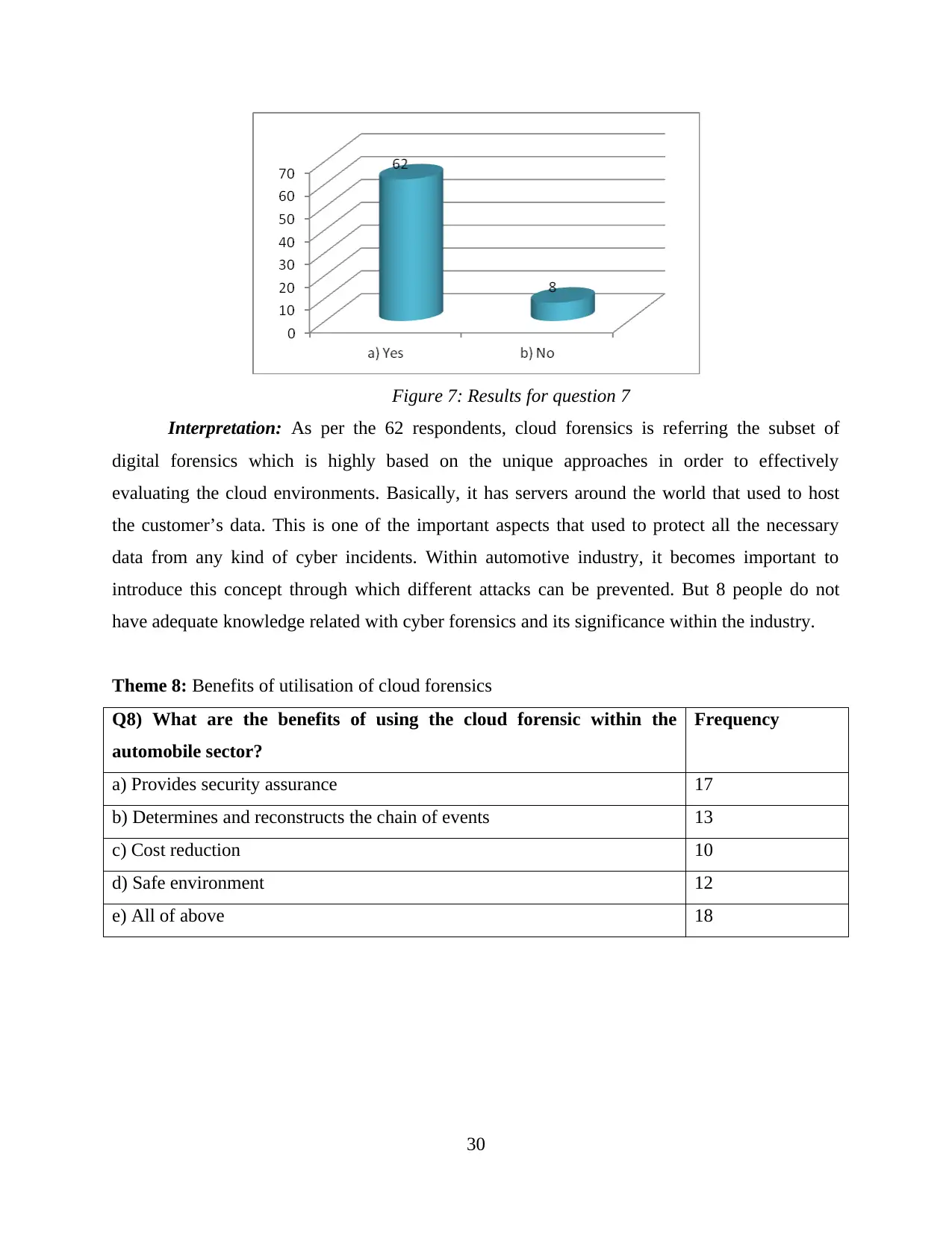
Interpretation: As per the 62 respondents, cloud forensics is referring the subset of
digital forensics which is highly based on the unique approaches in order to effectively
evaluating the cloud environments. Basically, it has servers around the world that used to host
the customer’s data. This is one of the important aspects that used to protect all the necessary
data from any kind of cyber incidents. Within automotive industry, it becomes important to
introduce this concept through which different attacks can be prevented. But 8 people do not
have adequate knowledge related with cyber forensics and its significance within the industry.
Theme 8: Benefits of utilisation of cloud forensics
Q8) What are the benefits of using the cloud forensic within the
automobile sector?
Frequency
a) Provides security assurance 17
b) Determines and reconstructs the chain of events 13
c) Cost reduction 10
d) Safe environment 12
e) All of above 18
30
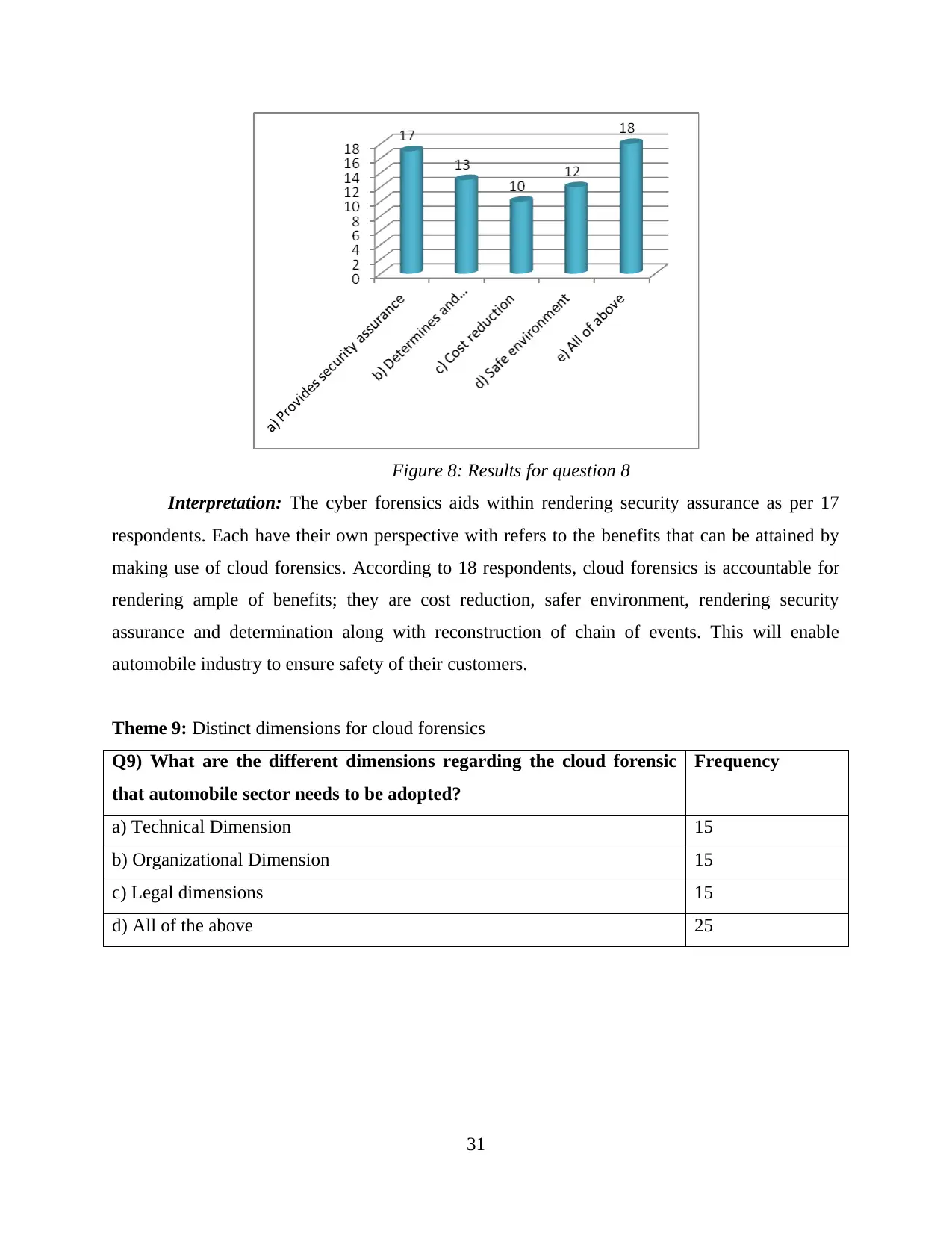
Interpretation: The cyber forensics aids within rendering security assurance as per 17
respondents. Each have their own perspective with refers to the benefits that can be attained by
making use of cloud forensics. According to 18 respondents, cloud forensics is accountable for
rendering ample of benefits; they are cost reduction, safer environment, rendering security
assurance and determination along with reconstruction of chain of events. This will enable
automobile industry to ensure safety of their customers.
Theme 9: Distinct dimensions for cloud forensics
Q9) What are the different dimensions regarding the cloud forensic
that automobile sector needs to be adopted?
Frequency
a) Technical Dimension 15
b) Organizational Dimension 15
c) Legal dimensions 15
d) All of the above 25
31
You're viewing a preview
Unlock full access by subscribing today!
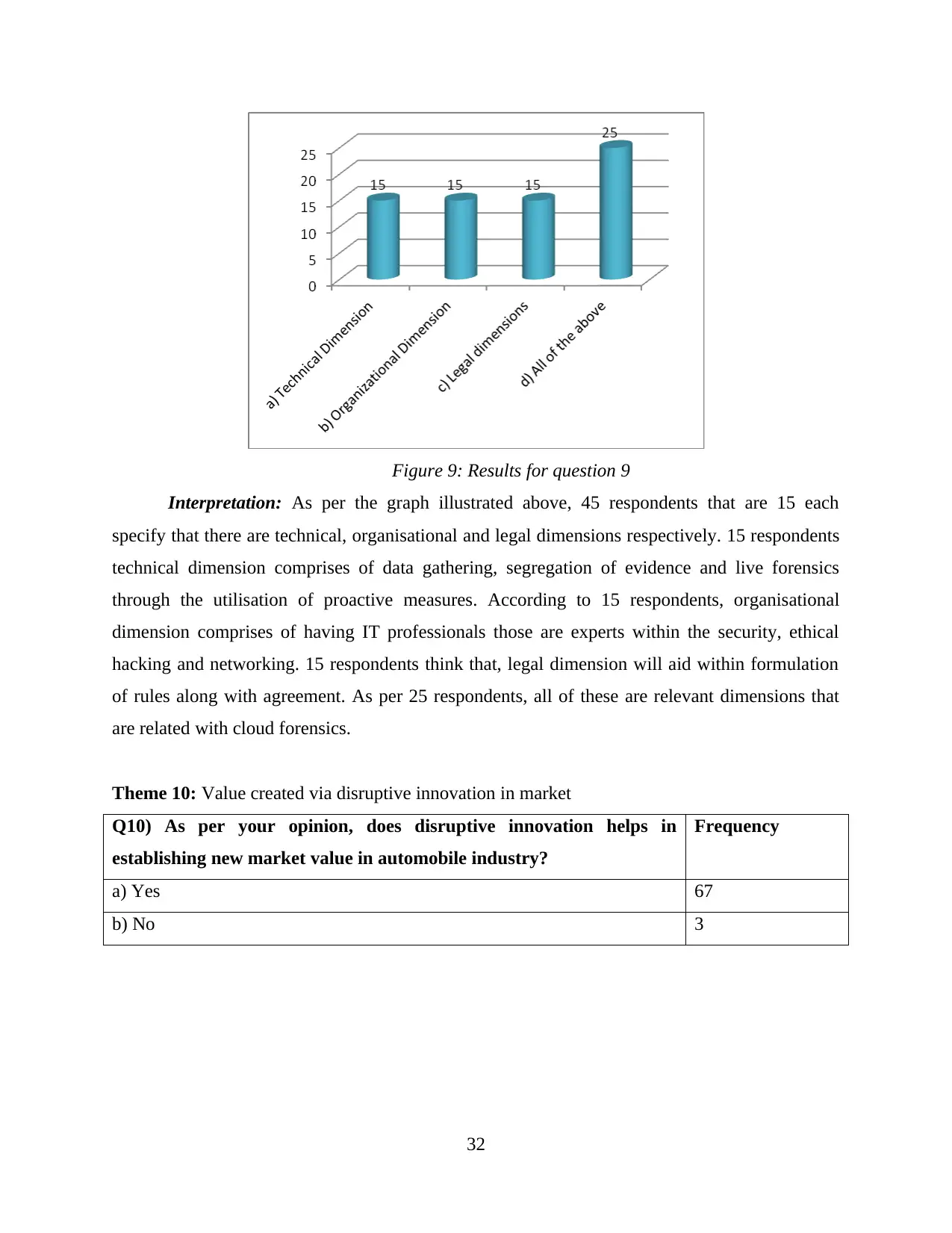
Interpretation: As per the graph illustrated above, 45 respondents that are 15 each
specify that there are technical, organisational and legal dimensions respectively. 15 respondents
technical dimension comprises of data gathering, segregation of evidence and live forensics
through the utilisation of proactive measures. According to 15 respondents, organisational
dimension comprises of having IT professionals those are experts within the security, ethical
hacking and networking. 15 respondents think that, legal dimension will aid within formulation
of rules along with agreement. As per 25 respondents, all of these are relevant dimensions that
are related with cloud forensics.
Theme 10: Value created via disruptive innovation in market
Q10) As per your opinion, does disruptive innovation helps in
establishing new market value in automobile industry?
Frequency
a) Yes 67
b) No 3
32
Paraphrase This Document
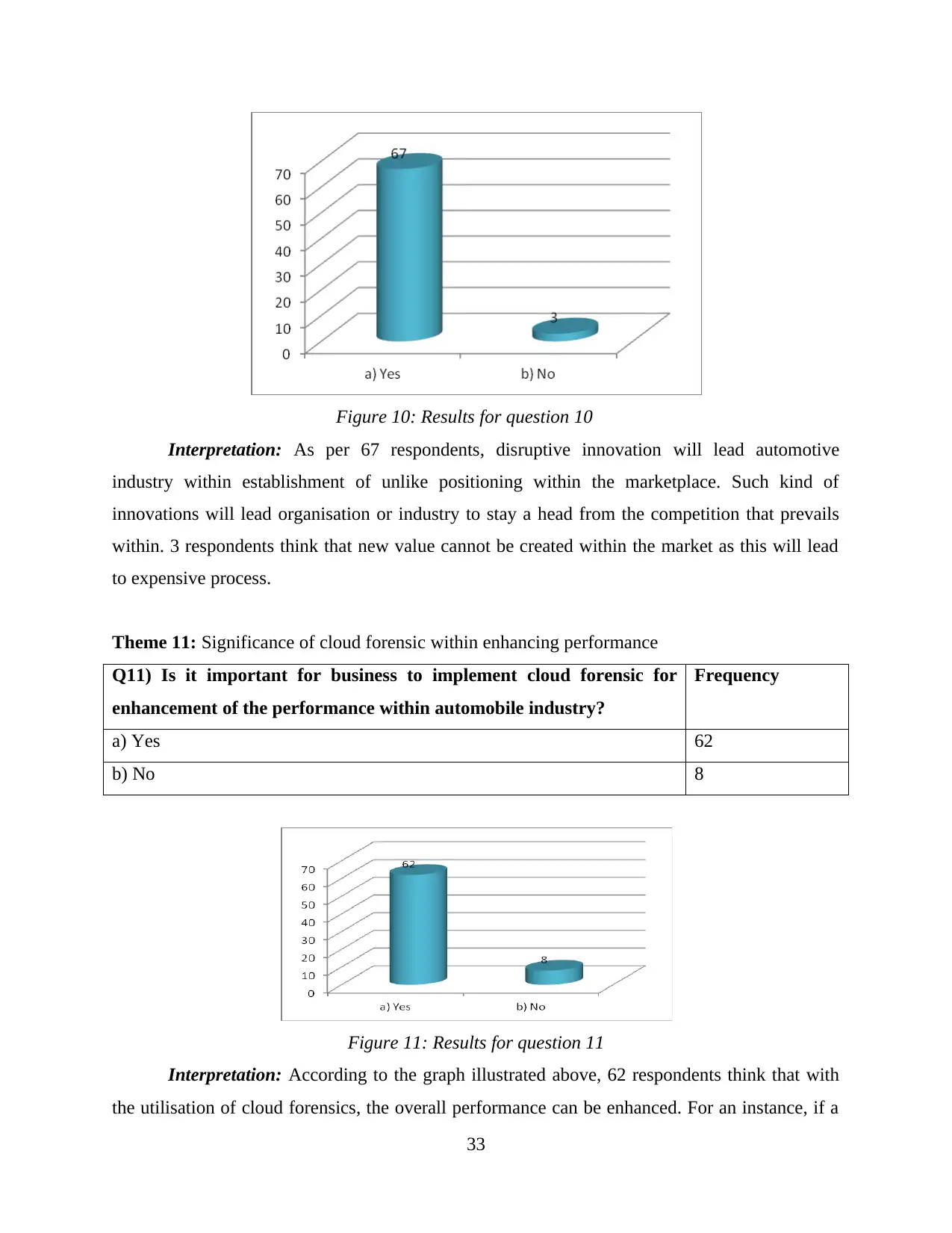
Interpretation: As per 67 respondents, disruptive innovation will lead automotive
industry within establishment of unlike positioning within the marketplace. Such kind of
innovations will lead organisation or industry to stay a head from the competition that prevails
within. 3 respondents think that new value cannot be created within the market as this will lead
to expensive process.
Theme 11: Significance of cloud forensic within enhancing performance
Q11) Is it important for business to implement cloud forensic for
enhancement of the performance within automobile industry?
Frequency
a) Yes 62
b) No 8
Figure 11: Results for question 11
Interpretation: According to the graph illustrated above, 62 respondents think that with
the utilisation of cloud forensics, the overall performance can be enhanced. For an instance, if a
33
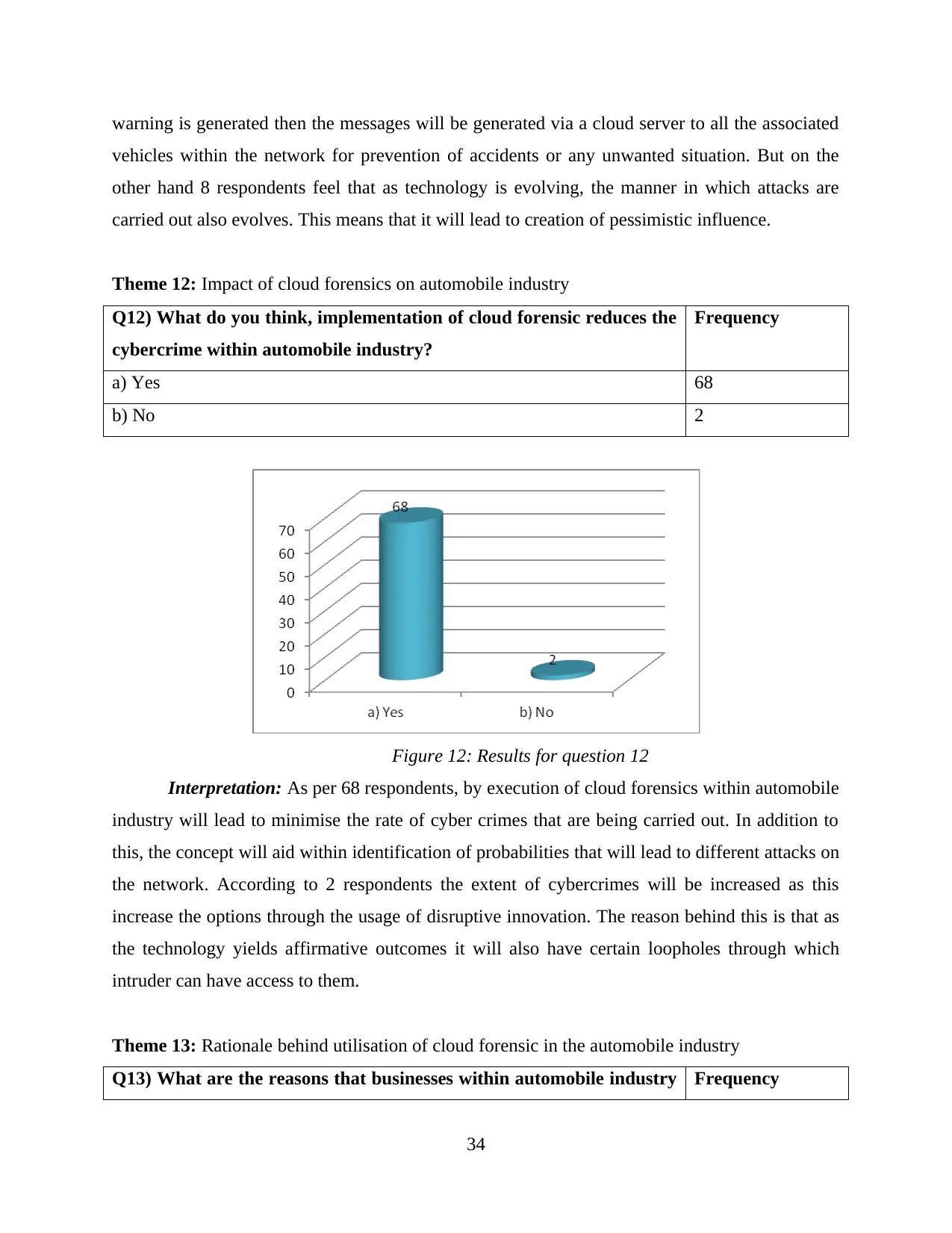
vehicles within the network for prevention of accidents or any unwanted situation. But on the
other hand 8 respondents feel that as technology is evolving, the manner in which attacks are
carried out also evolves. This means that it will lead to creation of pessimistic influence.
Theme 12: Impact of cloud forensics on automobile industry
Q12) What do you think, implementation of cloud forensic reduces the
cybercrime within automobile industry?
Frequency
a) Yes 68
b) No 2
Figure 12: Results for question 12
Interpretation: As per 68 respondents, by execution of cloud forensics within automobile
industry will lead to minimise the rate of cyber crimes that are being carried out. In addition to
this, the concept will aid within identification of probabilities that will lead to different attacks on
the network. According to 2 respondents the extent of cybercrimes will be increased as this
increase the options through the usage of disruptive innovation. The reason behind this is that as
the technology yields affirmative outcomes it will also have certain loopholes through which
intruder can have access to them.
Theme 13: Rationale behind utilisation of cloud forensic in the automobile industry
Q13) What are the reasons that businesses within automobile industry Frequency
34
You're viewing a preview
Unlock full access by subscribing today!
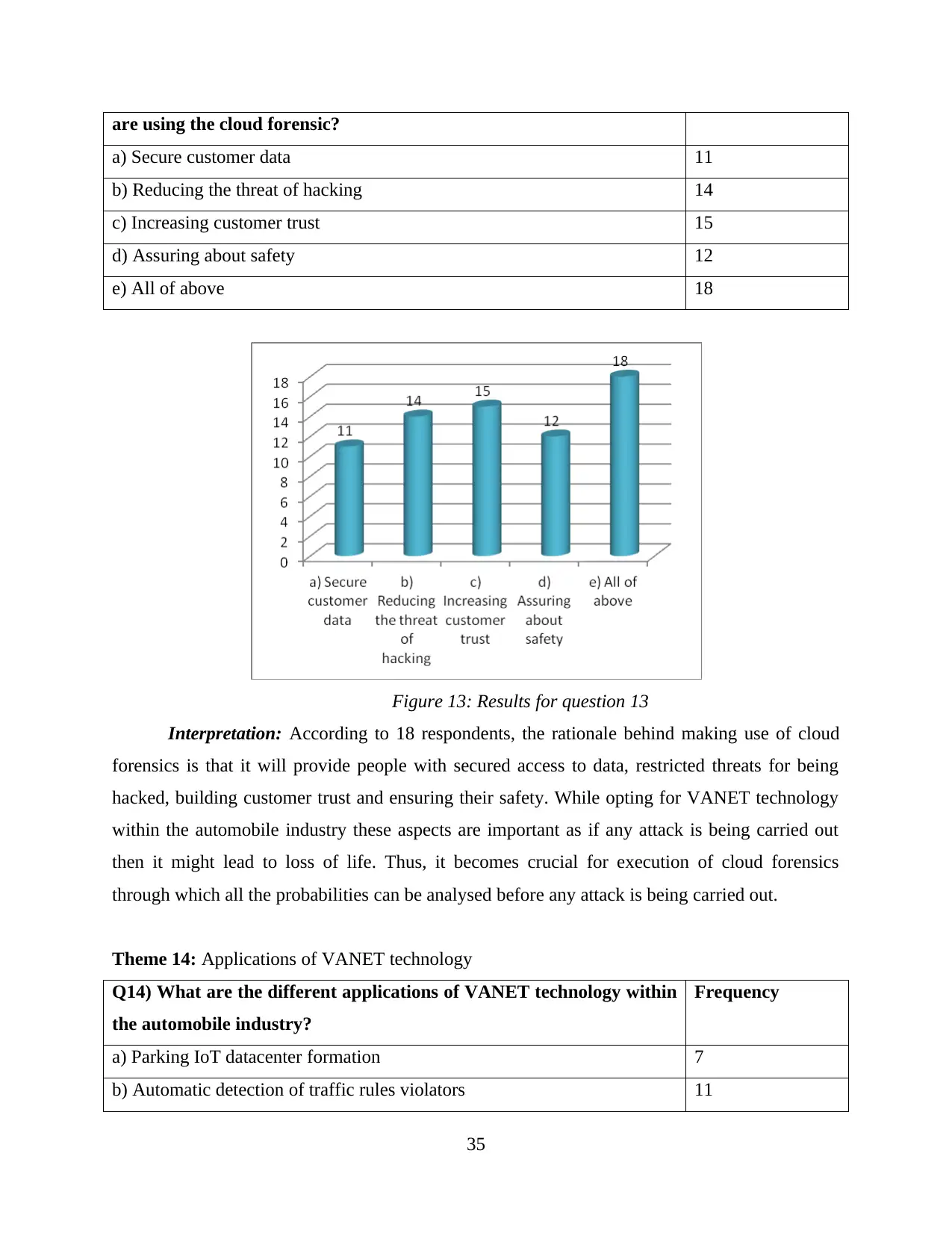
a) Secure customer data 11
b) Reducing the threat of hacking 14
c) Increasing customer trust 15
d) Assuring about safety 12
e) All of above 18
Figure 13: Results for question 13
Interpretation: According to 18 respondents, the rationale behind making use of cloud
forensics is that it will provide people with secured access to data, restricted threats for being
hacked, building customer trust and ensuring their safety. While opting for VANET technology
within the automobile industry these aspects are important as if any attack is being carried out
then it might lead to loss of life. Thus, it becomes crucial for execution of cloud forensics
through which all the probabilities can be analysed before any attack is being carried out.
Theme 14: Applications of VANET technology
Q14) What are the different applications of VANET technology within
the automobile industry?
Frequency
a) Parking IoT datacenter formation 7
b) Automatic detection of traffic rules violators 11
35
Paraphrase This Document

d) Parking space management 12
e) Easing Network congestion 11
f) All of the above 17
Figure 14: Results for question 14
Interpretation: VANET technology have different applications within the automobile
industry and this is clearly illustrated with the usage of graph shown above. According to 7
respondents, this technology can be utilised within parking IoT datacentre through which
vehicles can be parked easily without the accidents. In this context, as per 17 respondents, it is
identified that VANET technology have their application swithin the different aspectss that
involves parking IoT datacenter formation, automatic detection of traffic rules violators, accident
alerts at the intersection, parking space management along with easing Network congestion. This
implies that the number of road accident that takes place on per day basis will be declined which
means that the survival of people can be ensured.
36

Automotive is one of the most rapidly growing and evolving sectors within the bounds of
the corporate world. Over the course of time, this sector has undergone several changes that have
helped in transforming its nature and offerings. Changes take place in the automotive sector to
transform the traditional processes through the usage of new and emergent technologies. For the
improvement of driving procedures within the concerned industry, digitalisation needs to be
implemented across the whole of the value chain. This transcends the level of production. The
integration of technologies like big data, IoT, connectivity, and so on, has provided assistance in
altering the manufacturing process. Robotics is one of the key technologies that are being applied
within this sector to demonstrate innovation as well as creativity. This assists the businesses
functioning in automotive sector to appeal to the public at large by satisfying their needs as well
as wants in the long term. Further, the utilisation of mobility solutions has helped the automakers
to streamline the business operations and enhance the overall operational capacity.
Automotive industry and innovation are two interrelated concepts. The automotive sector
is characterised by firms that are encountering extensive competition from key market players.
The companies functioning within the bounds of the global automotive sector aim to launch new
and unique offerings in the market. The intent behind the same is to bring disruptive innovation
and disrupt the industry. For this purpose, businesses mainly make use of different kinds of
technologies that help in streamlining the business processes and enhancing the performance of
organisation. The technology driven trends or disruptive technologies help to revolutionise the
way in which the automakers respond to the constantly altering demands and needs of the
customer base across the globe. This also assists in maintaining the partnerships and driving
transformational change in the respective industry. Inflating the extent of digitisation and
automation along with the alteration of business models help in bringing revolution in the
confines of automotive industry. In this relation, some of the trends such as autonomous driving,
diverse mobility, electrification, and connectivity are constantly driving change within the
automotive sector. These trends help to bring disruptive innovation at market place.
To deal with the hyper-competition existing in automotive sector, VANET is a kind of
disruptive technology that is used by businesses pertaining to vehicle engineering and design
field. It is a powerful technology that helps the automakers to recognise the significance of
networking. Vehicular ad hoc network abbreviated as VANET refers to a network of vehicles
37
You're viewing a preview
Unlock full access by subscribing today!
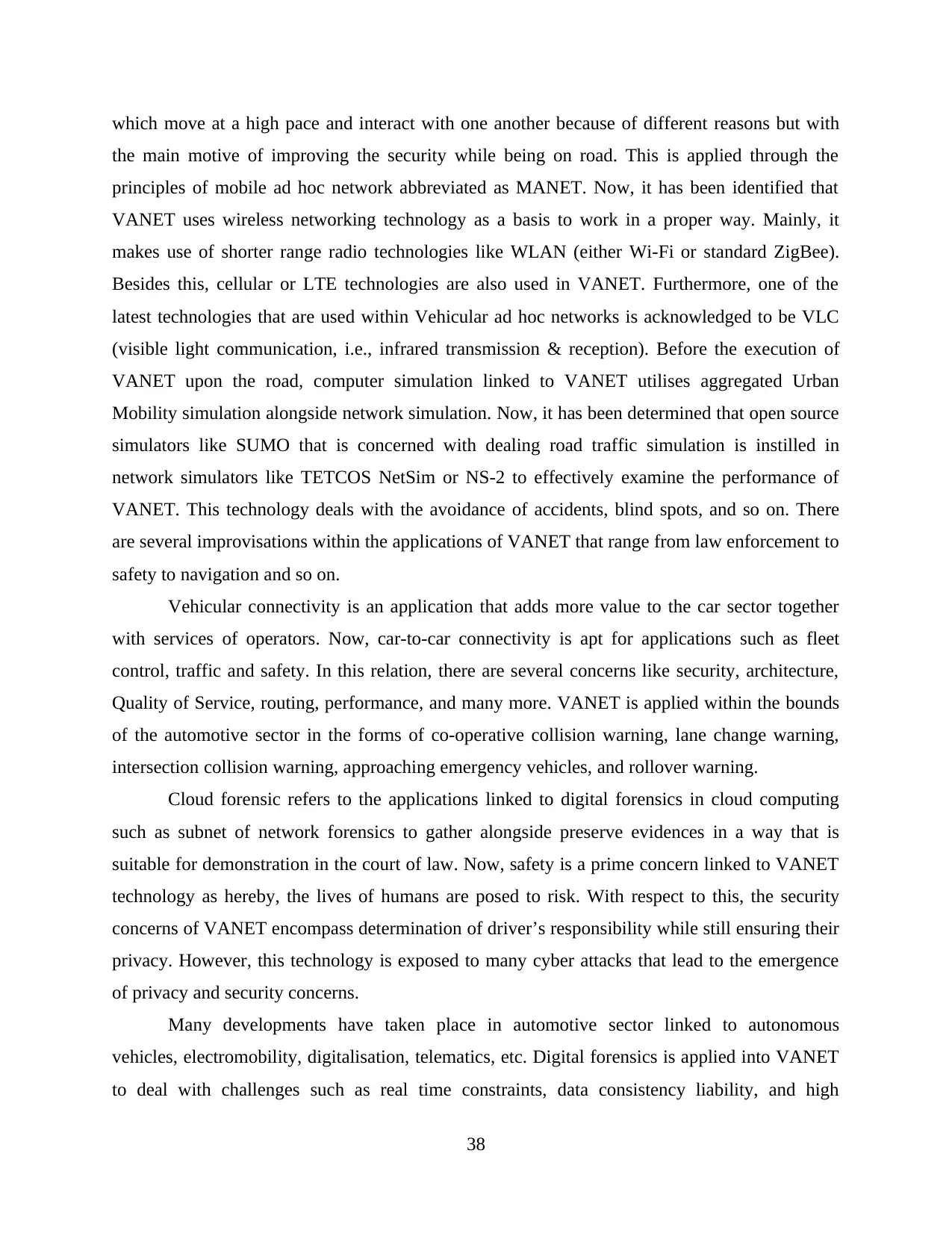
the main motive of improving the security while being on road. This is applied through the
principles of mobile ad hoc network abbreviated as MANET. Now, it has been identified that
VANET uses wireless networking technology as a basis to work in a proper way. Mainly, it
makes use of shorter range radio technologies like WLAN (either Wi-Fi or standard ZigBee).
Besides this, cellular or LTE technologies are also used in VANET. Furthermore, one of the
latest technologies that are used within Vehicular ad hoc networks is acknowledged to be VLC
(visible light communication, i.e., infrared transmission & reception). Before the execution of
VANET upon the road, computer simulation linked to VANET utilises aggregated Urban
Mobility simulation alongside network simulation. Now, it has been determined that open source
simulators like SUMO that is concerned with dealing road traffic simulation is instilled in
network simulators like TETCOS NetSim or NS-2 to effectively examine the performance of
VANET. This technology deals with the avoidance of accidents, blind spots, and so on. There
are several improvisations within the applications of VANET that range from law enforcement to
safety to navigation and so on.
Vehicular connectivity is an application that adds more value to the car sector together
with services of operators. Now, car-to-car connectivity is apt for applications such as fleet
control, traffic and safety. In this relation, there are several concerns like security, architecture,
Quality of Service, routing, performance, and many more. VANET is applied within the bounds
of the automotive sector in the forms of co-operative collision warning, lane change warning,
intersection collision warning, approaching emergency vehicles, and rollover warning.
Cloud forensic refers to the applications linked to digital forensics in cloud computing
such as subnet of network forensics to gather alongside preserve evidences in a way that is
suitable for demonstration in the court of law. Now, safety is a prime concern linked to VANET
technology as hereby, the lives of humans are posed to risk. With respect to this, the security
concerns of VANET encompass determination of driver’s responsibility while still ensuring their
privacy. However, this technology is exposed to many cyber attacks that lead to the emergence
of privacy and security concerns.
Many developments have taken place in automotive sector linked to autonomous
vehicles, electromobility, digitalisation, telematics, etc. Digital forensics is applied into VANET
to deal with challenges such as real time constraints, data consistency liability, and high
38
Paraphrase This Document
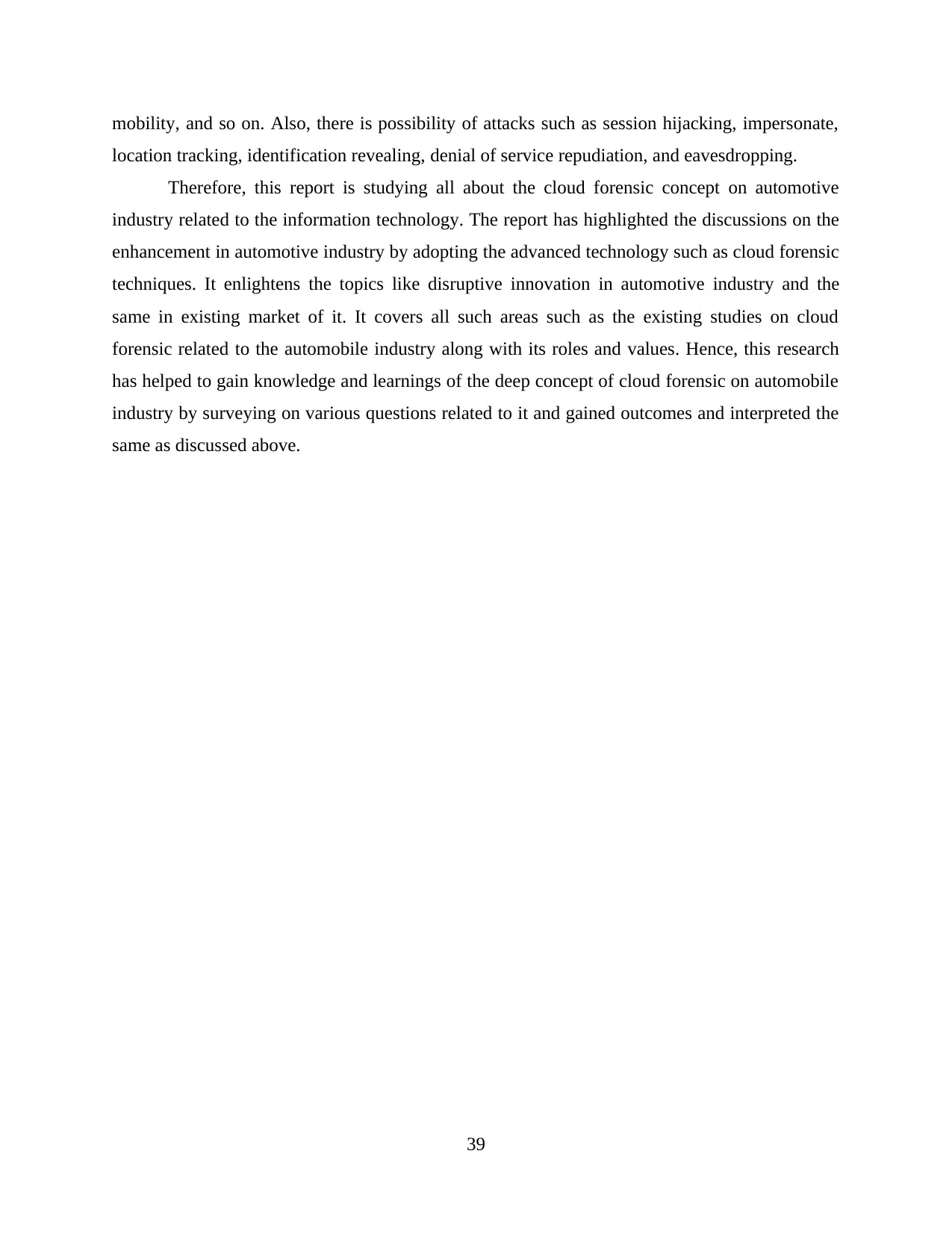
location tracking, identification revealing, denial of service repudiation, and eavesdropping.
Therefore, this report is studying all about the cloud forensic concept on automotive
industry related to the information technology. The report has highlighted the discussions on the
enhancement in automotive industry by adopting the advanced technology such as cloud forensic
techniques. It enlightens the topics like disruptive innovation in automotive industry and the
same in existing market of it. It covers all such areas such as the existing studies on cloud
forensic related to the automobile industry along with its roles and values. Hence, this research
has helped to gain knowledge and learnings of the deep concept of cloud forensic on automobile
industry by surveying on various questions related to it and gained outcomes and interpreted the
same as discussed above.
39
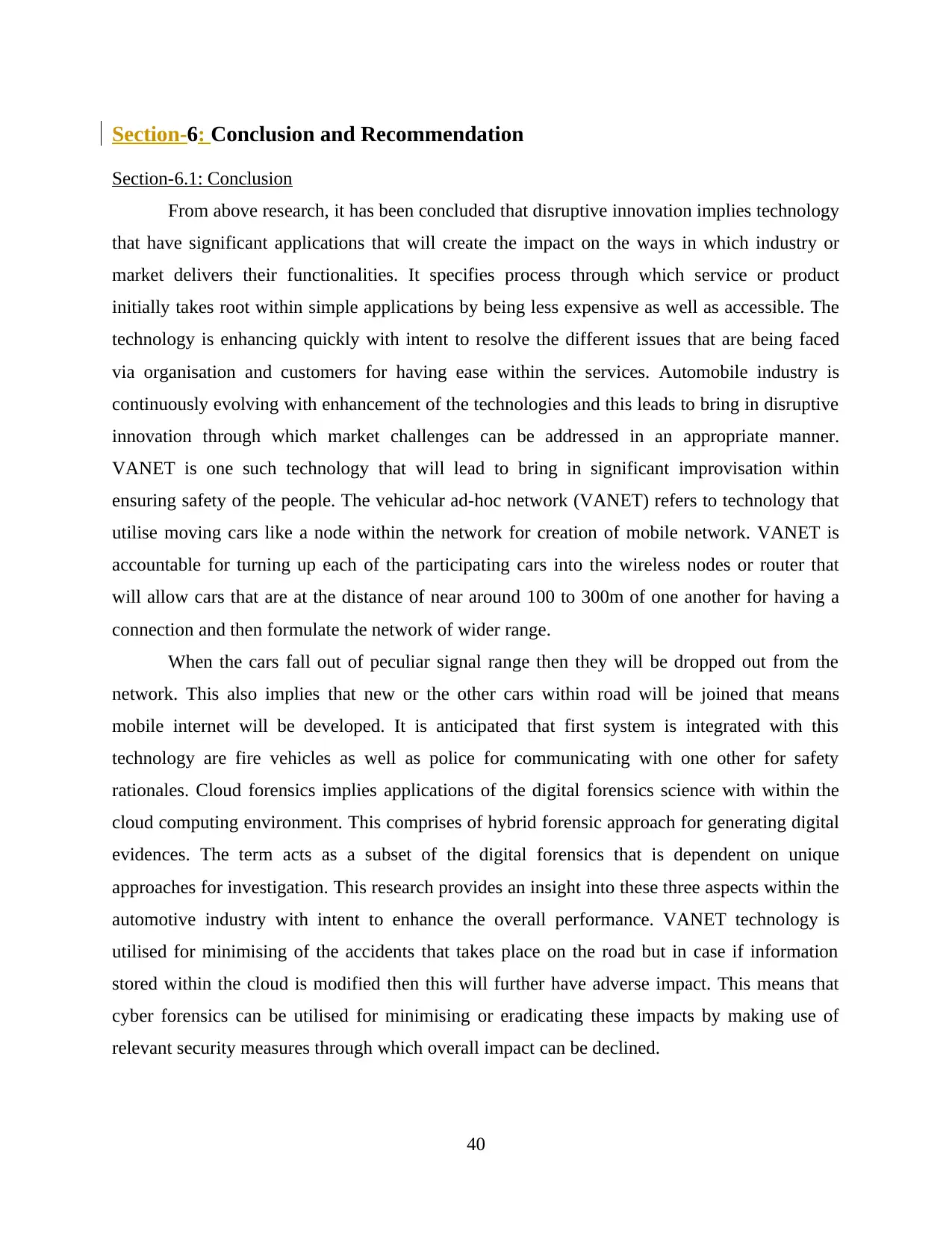
Section-6.1: Conclusion
From above research, it has been concluded that disruptive innovation implies technology
that have significant applications that will create the impact on the ways in which industry or
market delivers their functionalities. It specifies process through which service or product
initially takes root within simple applications by being less expensive as well as accessible. The
technology is enhancing quickly with intent to resolve the different issues that are being faced
via organisation and customers for having ease within the services. Automobile industry is
continuously evolving with enhancement of the technologies and this leads to bring in disruptive
innovation through which market challenges can be addressed in an appropriate manner.
VANET is one such technology that will lead to bring in significant improvisation within
ensuring safety of the people. The vehicular ad-hoc network (VANET) refers to technology that
utilise moving cars like a node within the network for creation of mobile network. VANET is
accountable for turning up each of the participating cars into the wireless nodes or router that
will allow cars that are at the distance of near around 100 to 300m of one another for having a
connection and then formulate the network of wider range.
When the cars fall out of peculiar signal range then they will be dropped out from the
network. This also implies that new or the other cars within road will be joined that means
mobile internet will be developed. It is anticipated that first system is integrated with this
technology are fire vehicles as well as police for communicating with one other for safety
rationales. Cloud forensics implies applications of the digital forensics science with within the
cloud computing environment. This comprises of hybrid forensic approach for generating digital
evidences. The term acts as a subset of the digital forensics that is dependent on unique
approaches for investigation. This research provides an insight into these three aspects within the
automotive industry with intent to enhance the overall performance. VANET technology is
utilised for minimising of the accidents that takes place on the road but in case if information
stored within the cloud is modified then this will further have adverse impact. This means that
cyber forensics can be utilised for minimising or eradicating these impacts by making use of
relevant security measures through which overall impact can be declined.
40
You're viewing a preview
Unlock full access by subscribing today!
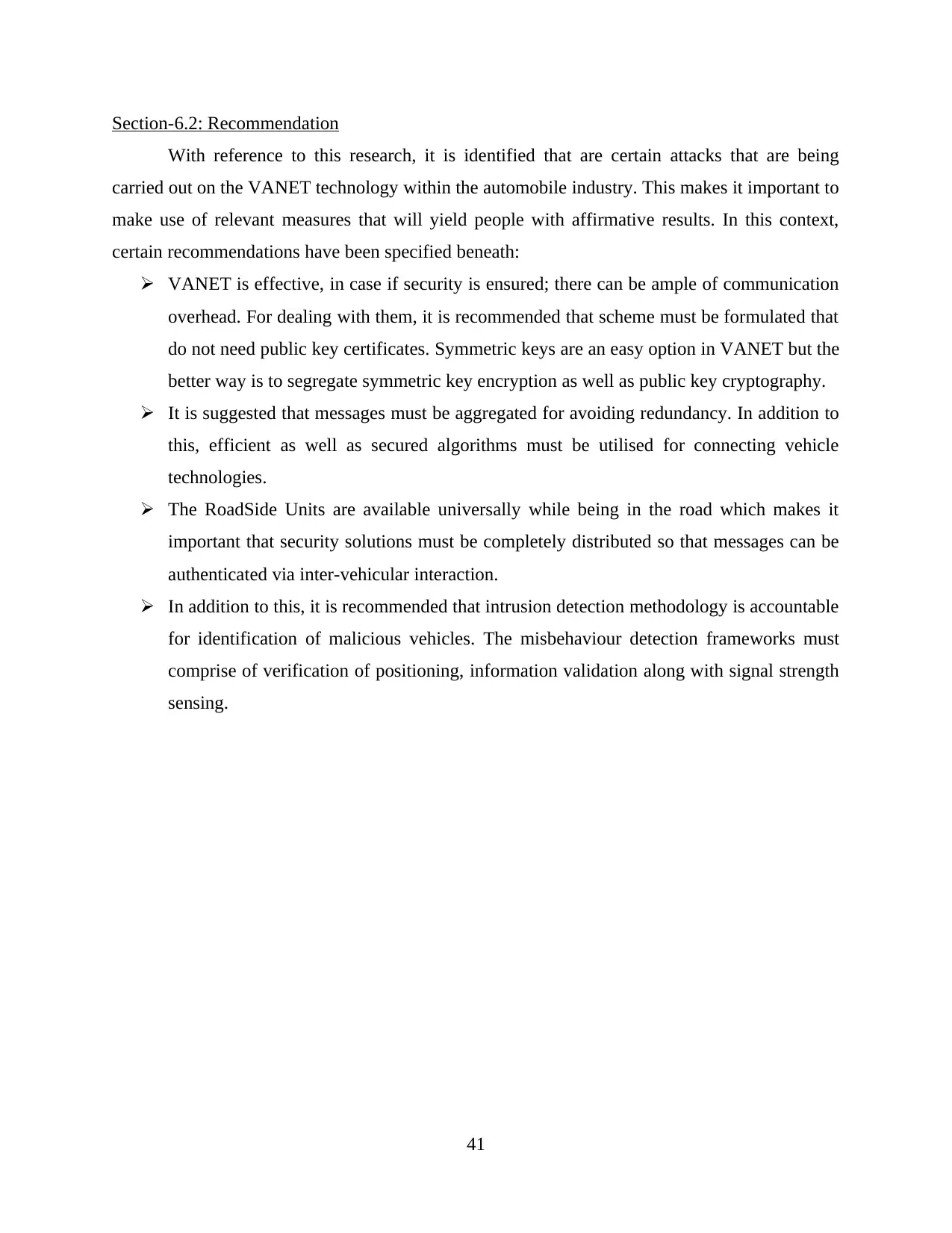
With reference to this research, it is identified that are certain attacks that are being
carried out on the VANET technology within the automobile industry. This makes it important to
make use of relevant measures that will yield people with affirmative results. In this context,
certain recommendations have been specified beneath:
VANET is effective, in case if security is ensured; there can be ample of communication
overhead. For dealing with them, it is recommended that scheme must be formulated that
do not need public key certificates. Symmetric keys are an easy option in VANET but the
better way is to segregate symmetric key encryption as well as public key cryptography.
It is suggested that messages must be aggregated for avoiding redundancy. In addition to
this, efficient as well as secured algorithms must be utilised for connecting vehicle
technologies.
The RoadSide Units are available universally while being in the road which makes it
important that security solutions must be completely distributed so that messages can be
authenticated via inter-vehicular interaction.
In addition to this, it is recommended that intrusion detection methodology is accountable
for identification of malicious vehicles. The misbehaviour detection frameworks must
comprise of verification of positioning, information validation along with signal strength
sensing.
41
Paraphrase This Document
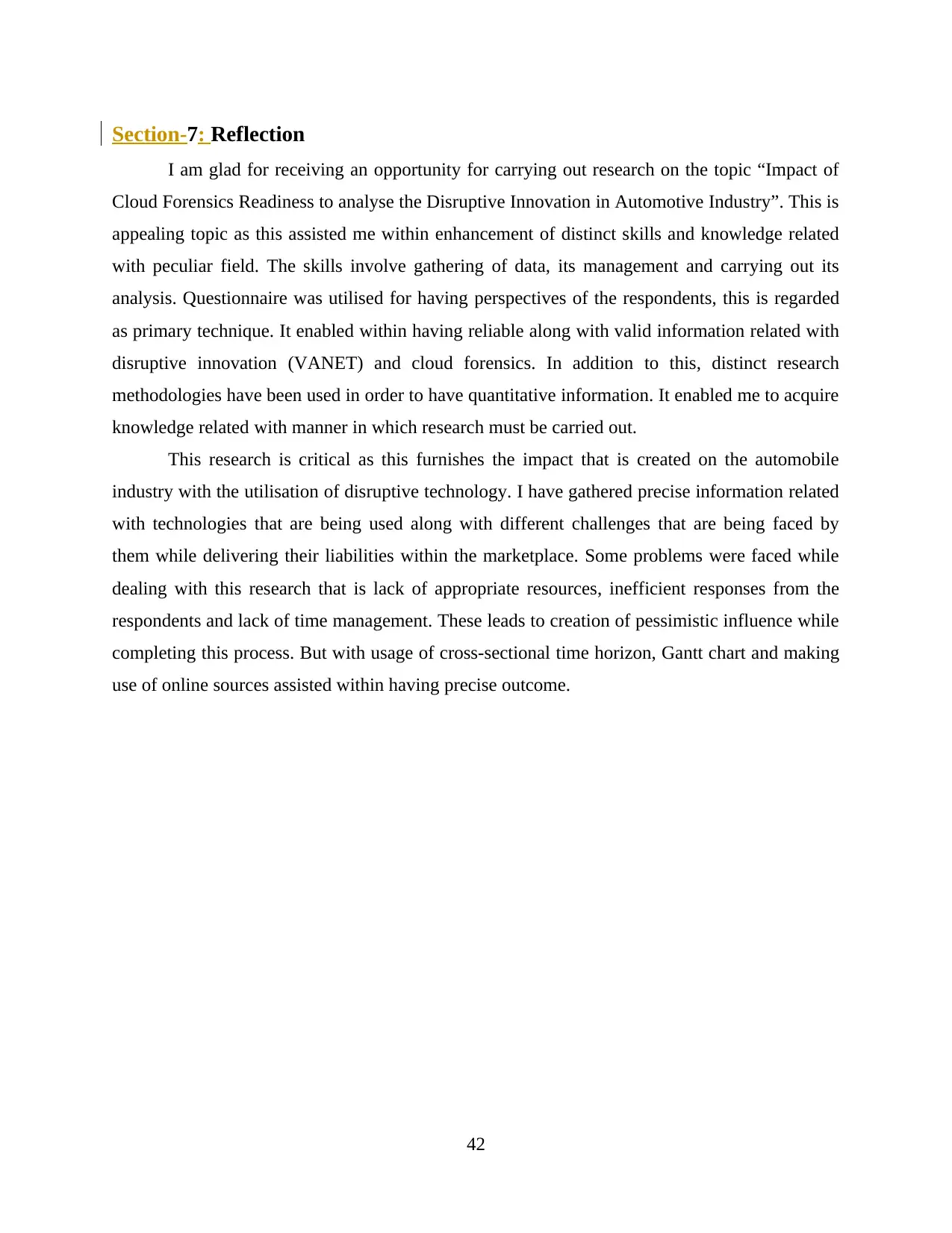
I am glad for receiving an opportunity for carrying out research on the topic “Impact of
Cloud Forensics Readiness to analyse the Disruptive Innovation in Automotive Industry”. This is
appealing topic as this assisted me within enhancement of distinct skills and knowledge related
with peculiar field. The skills involve gathering of data, its management and carrying out its
analysis. Questionnaire was utilised for having perspectives of the respondents, this is regarded
as primary technique. It enabled within having reliable along with valid information related with
disruptive innovation (VANET) and cloud forensics. In addition to this, distinct research
methodologies have been used in order to have quantitative information. It enabled me to acquire
knowledge related with manner in which research must be carried out.
This research is critical as this furnishes the impact that is created on the automobile
industry with the utilisation of disruptive technology. I have gathered precise information related
with technologies that are being used along with different challenges that are being faced by
them while delivering their liabilities within the marketplace. Some problems were faced while
dealing with this research that is lack of appropriate resources, inefficient responses from the
respondents and lack of time management. These leads to creation of pessimistic influence while
completing this process. But with usage of cross-sectional time horizon, Gantt chart and making
use of online sources assisted within having precise outcome.
42
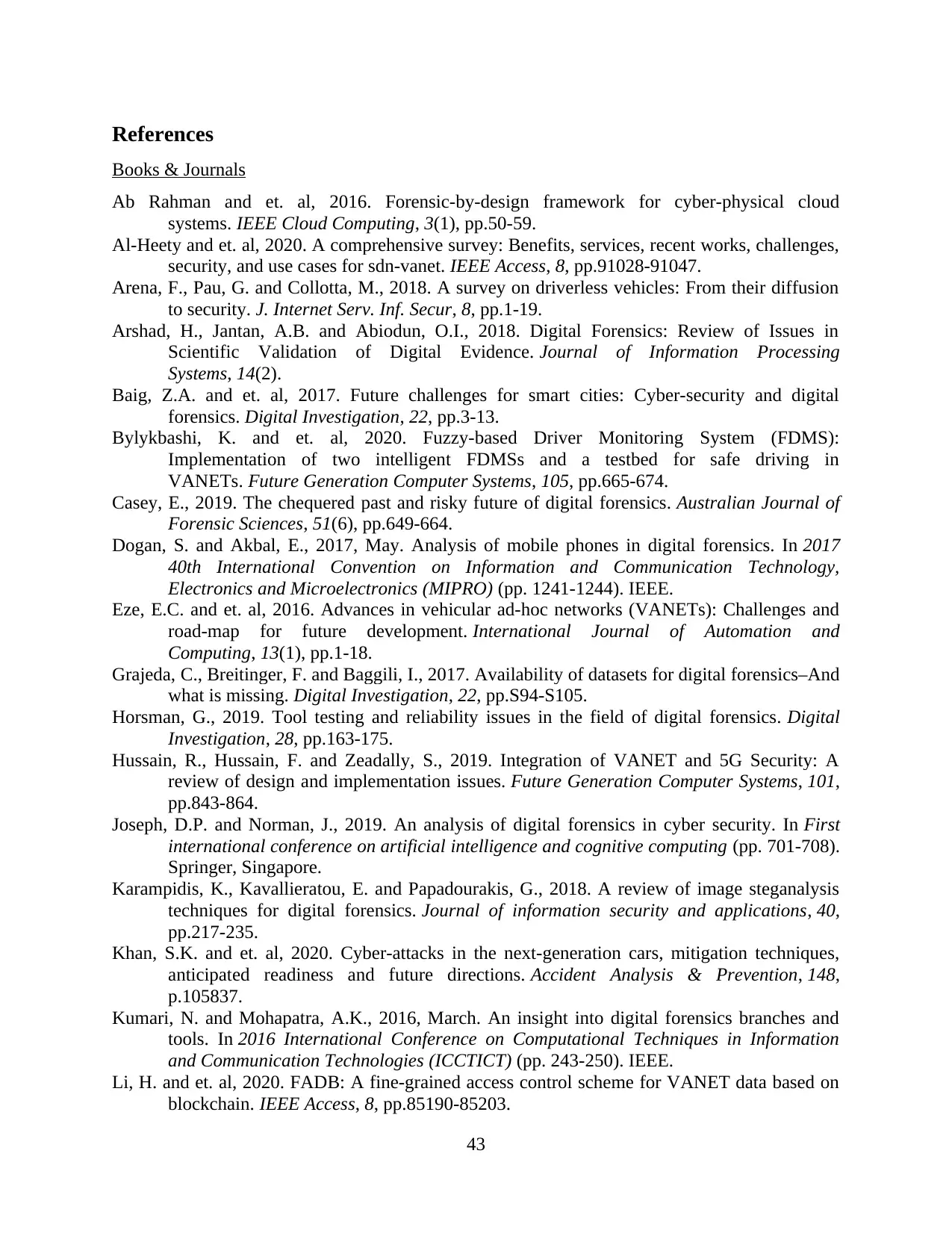
Books & Journals
Ab Rahman and et. al, 2016. Forensic-by-design framework for cyber-physical cloud
systems. IEEE Cloud Computing, 3(1), pp.50-59.
Al-Heety and et. al, 2020. A comprehensive survey: Benefits, services, recent works, challenges,
security, and use cases for sdn-vanet. IEEE Access, 8, pp.91028-91047.
Arena, F., Pau, G. and Collotta, M., 2018. A survey on driverless vehicles: From their diffusion
to security. J. Internet Serv. Inf. Secur, 8, pp.1-19.
Arshad, H., Jantan, A.B. and Abiodun, O.I., 2018. Digital Forensics: Review of Issues in
Scientific Validation of Digital Evidence. Journal of Information Processing
Systems, 14(2).
Baig, Z.A. and et. al, 2017. Future challenges for smart cities: Cyber-security and digital
forensics. Digital Investigation, 22, pp.3-13.
Bylykbashi, K. and et. al, 2020. Fuzzy-based Driver Monitoring System (FDMS):
Implementation of two intelligent FDMSs and a testbed for safe driving in
VANETs. Future Generation Computer Systems, 105, pp.665-674.
Casey, E., 2019. The chequered past and risky future of digital forensics. Australian Journal of
Forensic Sciences, 51(6), pp.649-664.
Dogan, S. and Akbal, E., 2017, May. Analysis of mobile phones in digital forensics. In 2017
40th International Convention on Information and Communication Technology,
Electronics and Microelectronics (MIPRO) (pp. 1241-1244). IEEE.
Eze, E.C. and et. al, 2016. Advances in vehicular ad-hoc networks (VANETs): Challenges and
road-map for future development. International Journal of Automation and
Computing, 13(1), pp.1-18.
Grajeda, C., Breitinger, F. and Baggili, I., 2017. Availability of datasets for digital forensics–And
what is missing. Digital Investigation, 22, pp.S94-S105.
Horsman, G., 2019. Tool testing and reliability issues in the field of digital forensics. Digital
Investigation, 28, pp.163-175.
Hussain, R., Hussain, F. and Zeadally, S., 2019. Integration of VANET and 5G Security: A
review of design and implementation issues. Future Generation Computer Systems, 101,
pp.843-864.
Joseph, D.P. and Norman, J., 2019. An analysis of digital forensics in cyber security. In First
international conference on artificial intelligence and cognitive computing (pp. 701-708).
Springer, Singapore.
Karampidis, K., Kavallieratou, E. and Papadourakis, G., 2018. A review of image steganalysis
techniques for digital forensics. Journal of information security and applications, 40,
pp.217-235.
Khan, S.K. and et. al, 2020. Cyber-attacks in the next-generation cars, mitigation techniques,
anticipated readiness and future directions. Accident Analysis & Prevention, 148,
p.105837.
Kumari, N. and Mohapatra, A.K., 2016, March. An insight into digital forensics branches and
tools. In 2016 International Conference on Computational Techniques in Information
and Communication Technologies (ICCTICT) (pp. 243-250). IEEE.
Li, H. and et. al, 2020. FADB: A fine-grained access control scheme for VANET data based on
blockchain. IEEE Access, 8, pp.85190-85203.
43
You're viewing a preview
Unlock full access by subscribing today!
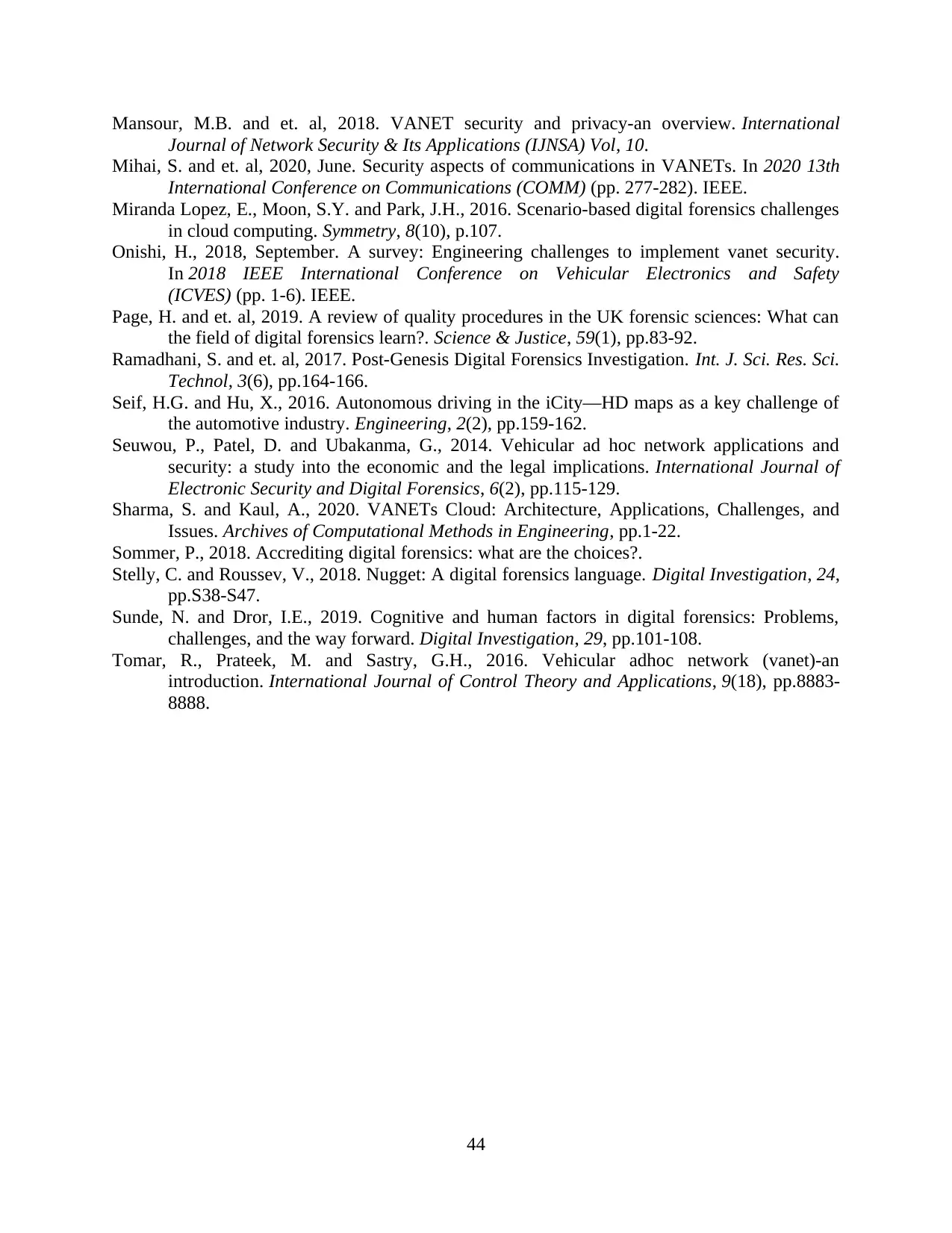
Journal of Network Security & Its Applications (IJNSA) Vol, 10.
Mihai, S. and et. al, 2020, June. Security aspects of communications in VANETs. In 2020 13th
International Conference on Communications (COMM) (pp. 277-282). IEEE.
Miranda Lopez, E., Moon, S.Y. and Park, J.H., 2016. Scenario-based digital forensics challenges
in cloud computing. Symmetry, 8(10), p.107.
Onishi, H., 2018, September. A survey: Engineering challenges to implement vanet security.
In 2018 IEEE International Conference on Vehicular Electronics and Safety
(ICVES) (pp. 1-6). IEEE.
Page, H. and et. al, 2019. A review of quality procedures in the UK forensic sciences: What can
the field of digital forensics learn?. Science & Justice, 59(1), pp.83-92.
Ramadhani, S. and et. al, 2017. Post-Genesis Digital Forensics Investigation. Int. J. Sci. Res. Sci.
Technol, 3(6), pp.164-166.
Seif, H.G. and Hu, X., 2016. Autonomous driving in the iCity—HD maps as a key challenge of
the automotive industry. Engineering, 2(2), pp.159-162.
Seuwou, P., Patel, D. and Ubakanma, G., 2014. Vehicular ad hoc network applications and
security: a study into the economic and the legal implications. International Journal of
Electronic Security and Digital Forensics, 6(2), pp.115-129.
Sharma, S. and Kaul, A., 2020. VANETs Cloud: Architecture, Applications, Challenges, and
Issues. Archives of Computational Methods in Engineering, pp.1-22.
Sommer, P., 2018. Accrediting digital forensics: what are the choices?.
Stelly, C. and Roussev, V., 2018. Nugget: A digital forensics language. Digital Investigation, 24,
pp.S38-S47.
Sunde, N. and Dror, I.E., 2019. Cognitive and human factors in digital forensics: Problems,
challenges, and the way forward. Digital Investigation, 29, pp.101-108.
Tomar, R., Prateek, M. and Sastry, G.H., 2016. Vehicular adhoc network (vanet)-an
introduction. International Journal of Control Theory and Applications, 9(18), pp.8883-
8888.
44
Related Documents
Your All-in-One AI-Powered Toolkit for Academic Success.
+13062052269
info@desklib.com
Available 24*7 on WhatsApp / Email
![[object Object]](/_next/static/media/star-bottom.7253800d.svg)
© 2024 | Zucol Services PVT LTD | All rights reserved.





